Twice each of 2.5 GbE and M.2, an HDMI connection and USB ports with 10 Gbit/s: The specs of the TerraMaster F4-423 sound promising again. In practice, the NAS system also runs stably and delivers good results. But it's not enough for very good results and connection to Synology and QNAP – not even with TOS 5.
Table of contents
- 1 Against the competition with an Intel CPU, 2.5 GbE and M.2 SSDs
- Technical details of the TerraMaster F4-423
- Start-up and software of the TerraMaster F4- 423
- 2 transfer rates, TOS 4 vs. TOS 5 and USB backup
- File transfer
- Encryption
- Link Aggregation
- TOS 4 vs. TOS 5 of file transfer
- USB backup
- 3 SSD cache, volume, power consumption and conclusion
- SSD cache with NVMe SSDs
- Volume & Power consumption
- Price comparison
- Conclusion
TerraMaster advertises the NAS system F4-423 as a high-performance system for small and medium-sized businesses. It offers space for four drives and uses two network connections with 2.5 Gbit/s. In contrast to the F4-422 (test), the manufacturer does without 10 GbE, but an HDMI connection is no longer only installed internally. An Intel Celeron processor provides the necessary computing power. An SSD cache can also be set up via two M.2 slots and the RAM can be expanded if desired. Shortly before the publication of this test report, TerraMaster also published TOS 5.0, the heavily revised version of its own NAS operating system, which is why it is also briefly discussed in the test.
The TerraMaster F4-423 currently costs 500 euros in retail and is only available from the manufacturer's Amazon shop*. In addition to the NAS with an external power supply, buyers receive a network cable and suitable screws for attaching 2.5-inch drives. As always, the latter equipment must be purchased separately.
Technical details of the TerraMaster F4-423
4-core Celeron and 4 GB RAM
The main processor in the F4-423 is an Intel Celeron N5105/N5095 from the Jasper Lake family, which offers four cores clocked at 2.0 GHz. The family does not have hyper-threading, so it does not provide any additional threads. The maximum turbo clock frequency is 2.9 GHz, the TDP of the 10 nm processor is 15 watts. Drive encryption is accelerated using AES-NI. For example, QNAP also uses this model in the NAS of the TS-x64 series.
Space for 4 + 2 drives and RAM upgrade< /h3>
The TerraMaster F4-423 offers four drive frames for classic hard drives and SSDs, which can be installed in both 3.5 and 2.5 inch formats. The drives do not have to be screwed to the frame in both cases, because TerraMaster now also uses the method already known from other manufacturers to hold the 3.5-inch drives with lateral plastic strips instead of screwing them. Only smaller 2.5 inch disks still have to be screwed in. There are also two M.2 slots inside that can accommodate M.2 NVMe SSDs in 2280 format. To install them, however, the NAS must be disassembled. In order to be able to remove the aluminum case, six screws on the plastic back have to be loosened, then it can be removed without also having to loosen the screws on the underside. On the outward-facing side of the motherboard, not only are the two M.2 slots placed, but also another RAM slot that is unequipped ex works. The 4 GB DDR4 SO-DIMM with 2,133 MHz, with which the NAS is equipped, can be expanded in this way. Intel also officially supports 2,933 MHz memory on the platform. TerraMaster specifies the maximum as 32 GB, i.e. two modules with 16 GB each – Intel itself states 16 GB as the official maximum for the N5095. The second module is installed on the inside of the circuit board, but with a little skill it can also be replaced without having to further disassemble the NAS.
-
 TerraMaster F4-423: Space for M.2 SSDs and a RAM upgrade after disassembly
TerraMaster F4-423: Space for M.2 SSDs and a RAM upgrade after disassembly
Image 1 of 4
 TerraMaster F4-423: The factory installed RAM module
TerraMaster F4-423: The factory installed RAM module TerraMaster F4-423: DDR4 SO-DIMM only with 2133 MHz
TerraMaster F4-423: DDR4 SO-DIMM only with 2133 MHz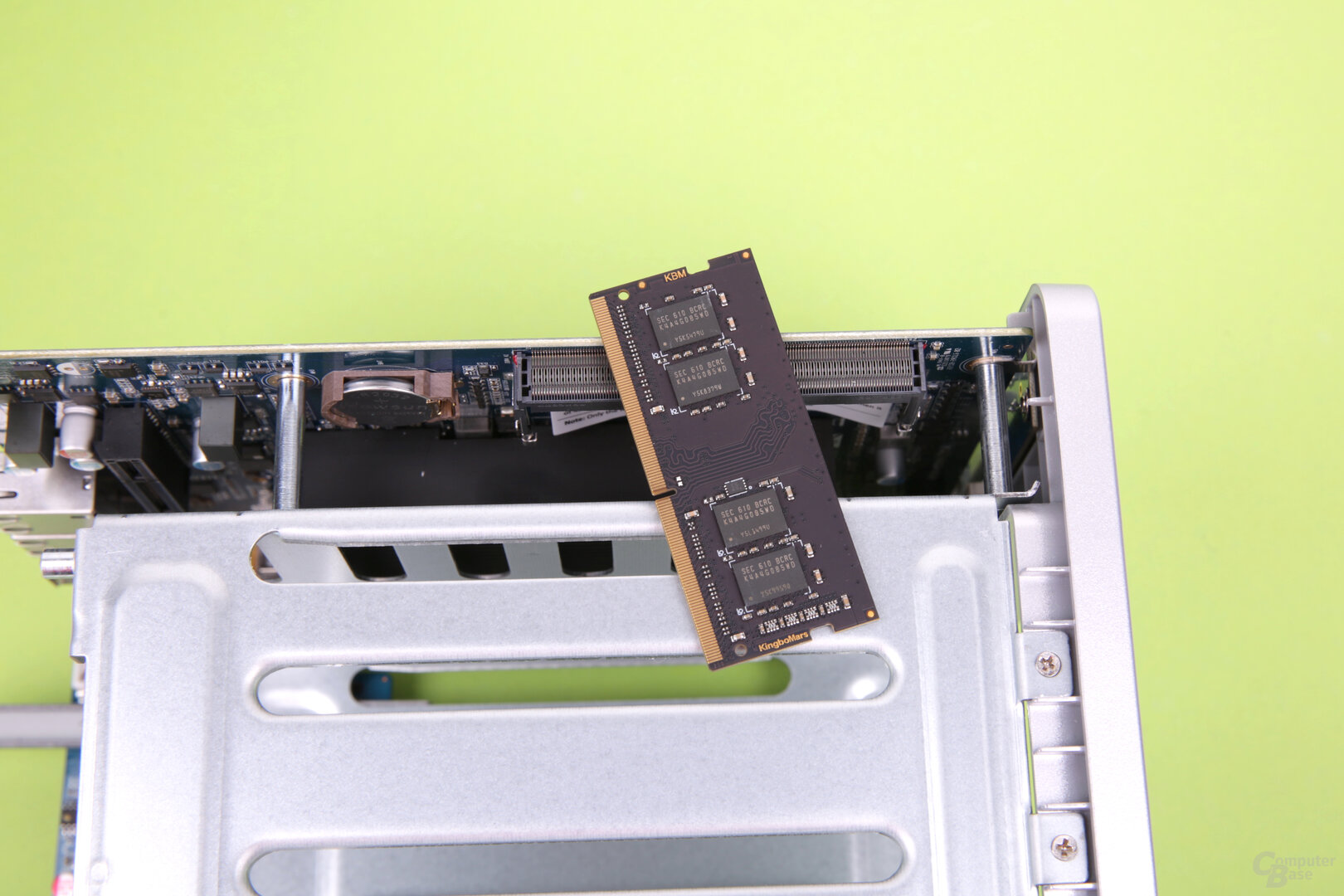 TerraMaster F4-423
TerraMaster F4-423A special feature when using M.2 SSDs is that they can also be used as a primary volume and not just as an SSD cache. The four drive frames can not only remain empty, but theoretically they can be supplemented by two more. Asustor also allows such use of the M.2 drives in its NAS systems, while Synology does not. However, the M.2 slots in TerraMaster are implemented as PCIe Gen3 x1, which is why they slow down current drives. The Seagate IronWolf 510 used in the test achieves up to 2,600 MB/s, but is slowed down to around 1,000 MB/s in the F4-423 because the ports are connected too slowly.
Front LEDs and power button
The metal case, which weighs around 2.3 kg and has a plastic front and back, measures 227 × 225 × 136 mm (H × W × D). The status LEDs for the system, the network and the drives are located on the front next to the on/off switch.
 TerraMaster F4-423
TerraMaster F4-423Network, HDMI and USB rear
All other connections of the F4-423 are housed on the back. In addition to the two LAN ports with 2.5 Gbit/s, there are two USB-A sockets according to USB 3.2 Gen 2, so they offer up to 10 Gbit/s. The two network interfaces can be operated bundled with link aggregation, with the NAS offering various modes with either failover or load balancing, provided the switch is not used for this or it does not support it. In addition, the already mentioned HDMI connection is located on the back, which supports a maximum of 4K resolution with up to 60 Hz. Installing a PCIe expansion card to add 10 Gigabit Ethernet or additional M.2 slots is not possible in the F4-423.
-
 TerraMaster F4-423: HDMI, USB and LAN on the back
TerraMaster F4-423: HDMI, USB and LAN on the back
Image 1 of 2
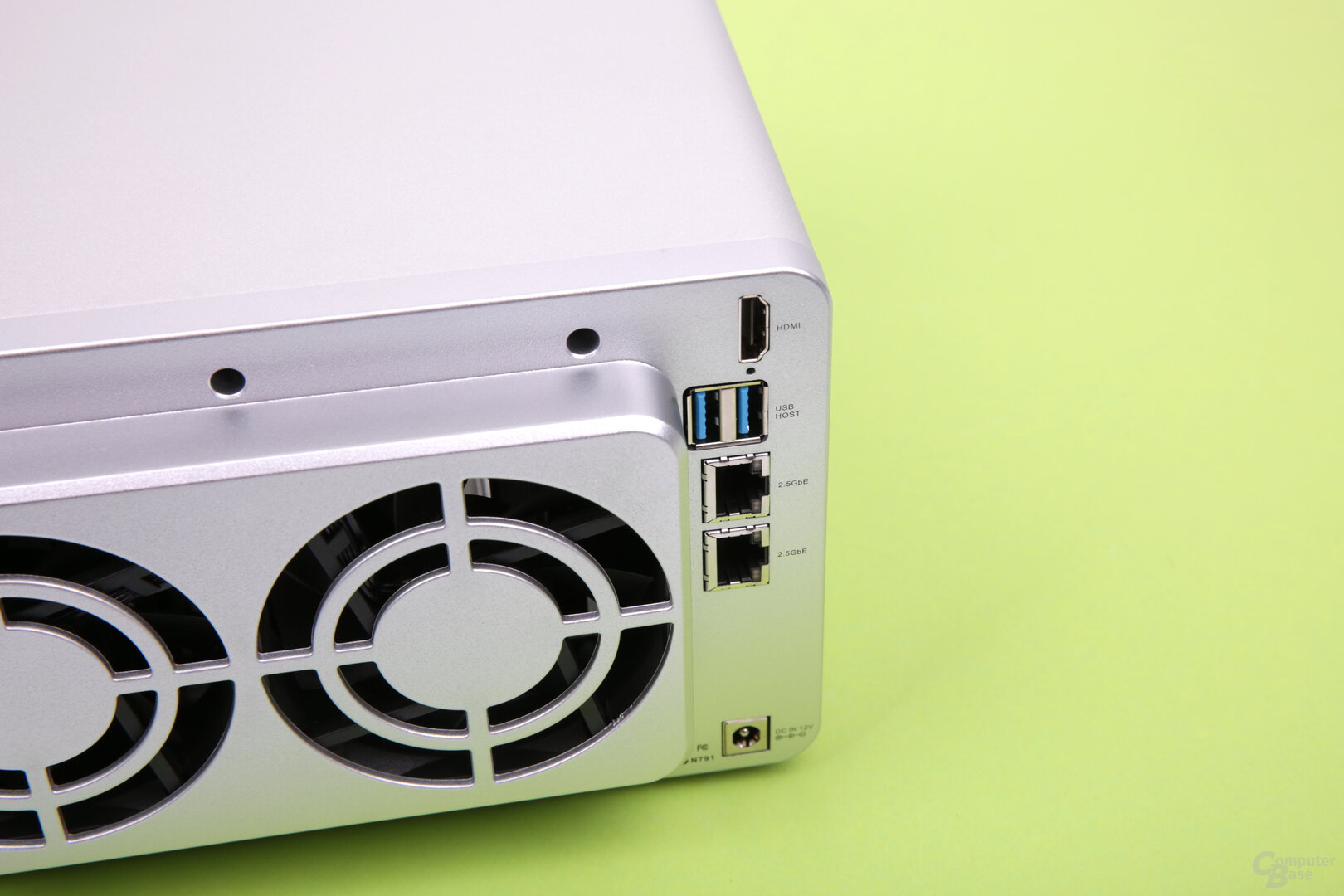 TerraMaster F4-423: HDMI, USB and LAN on the back
TerraMaster F4-423: HDMI, USB and LAN on the backTwo 80mm fans cool the NAS
The drives and the system are cooled by two 80 × 80 × 25 mm fans that blow the air out of the system at the back. Using the TOS operating system, they can either be operated automatically with temperature control or their speed can be controlled in the low, mid and high stages. The Celeron CPU is covered by a passive cooler and is not actively cooled in addition. The external power pack of the TerraMaster F4-423 delivers a maximum of 90 watts.
 TerraMaster F4-423: The fans can be replaced
TerraMaster F4-423: The fans can be replaced TerraMaster F4-423 Synology DS920+ TerraMaster F4-422 Asustor Lockerstor 2 (AS6602T) Synology DS720+ QNAP TS-253D SoC: Intel Celeron N5105
x86
2.00 GHz, 4 cores, 4 threads Intel Celeron J4125
x86
2.00 GHz, 4 cores, 4 threads Intel Celeron J3455
x86
1.50 GHz, 4 cores, 4 threads Intel Celeron J4125
x86
2.00 GHz, 4 cores, 4 threads RAM: 4,096 MB 4,096 MB Variant8,192 MB 2,048 MB 4,096 MB Hard disk bays: 4 2 S-ATA standard: I/II/III HDD format: 2.5" & 3.5″ RAID Levels: Single Disk, JBOD, RAID 0, RAID 1
RAID 5, RAID 5 + Hot Spare, RAID 6, RAID 10 Single Disk, JBOD, RAID 0, RAID 1 M.2 ports for SSD cache: 2 – 2 – I/O ports: 2 × 2.5 Gbit LAN
2 × USB 3.0
HDMI 2 × 1 Gbit LAN
2 × USB 3.0, 1 × eSATA 2 × 1 Gbit LAN
1 × 10 Gbit LAN
2 × USB 3.0 2 × 2.5 Gbit LAN
3 × USB 3.0
HDMI 2 × 1 Gbit LAN
2 × USB 3.0, 1 × eSATA 2 × 2.5 Gbit LAN
2 × USB 2.0, 3 × USB 3.0
HDMI, infrared, PCIe Slot Wake on LAN: Yes Encryption: AES-256 (folder based) AES-256 (folder and drive based) Fan: 2 × 80 × 80 × 25 mm
(non-decoupled) 2 × 92 × 92 × 25 mm 2 × 80 × 80 × 25 mm
(not decoupled) 1 × 70 × 70 × 25 mm
(not decoupled) 1 × 92 × 92 × 25 mm
(not decoupled) 1 × 70 × 70 × 25 mm
(not decoupled) Power supply unit: 90 watts (external) 100 watts (external) 90 watts (external) 65 watts (external) Dimensions (H×W×D): 227.0 × 225.0 × 136.0 mm 166.0 × 199.0 × 223.0 mm 227.0 × 225.0 × 136.0 mm 163.5 × 108.0 × 230.0 mm 166, 0 × 106.0 × 223.0 mm 168.0 × 105.0 × 226.0 mm Empty weight: 2.30 kg 2.24 kg 2.35 kg 2.00 kg 1.51 kg 1.48 kg Price: €499.99 from €564 €499.99 from €412/– €458.20 from €319
HDMI port for hobbyists only
However, the F4-423's HDMI output has had very little use so far. With a connected keyboard, it does allow command line access to the Linux system, but TerraMaster does not offer any graphical user interface that can also be used for multimedia output. The F4-423 only streams content via the network, but cannot output videos and photos via HDMI or even open a browser or YouTube, as is known from QNAP or Asustor with the HD Station or Portal. For hobbyists, however, it creates additional space for an alternative operating system on the device. Since TerraMaster has been installing HDMI in the devices for around two years, but has not yet supplied any software, it cannot be assumed that this will change in the near future.
-
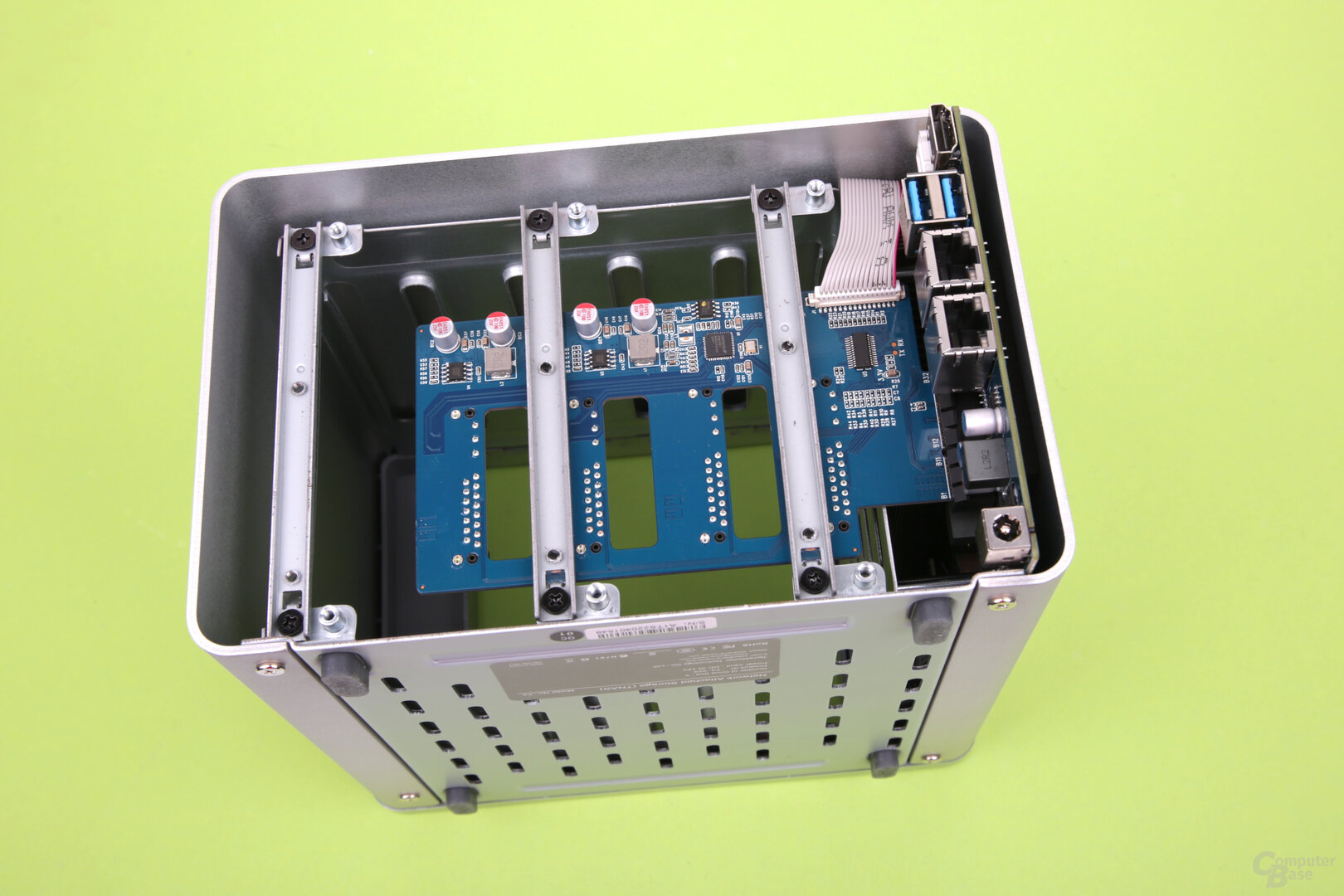 TerraMaster F4-423
TerraMaster F4-423
Image 1 of 3
 TerraMaster F4- 423
TerraMaster F4- 423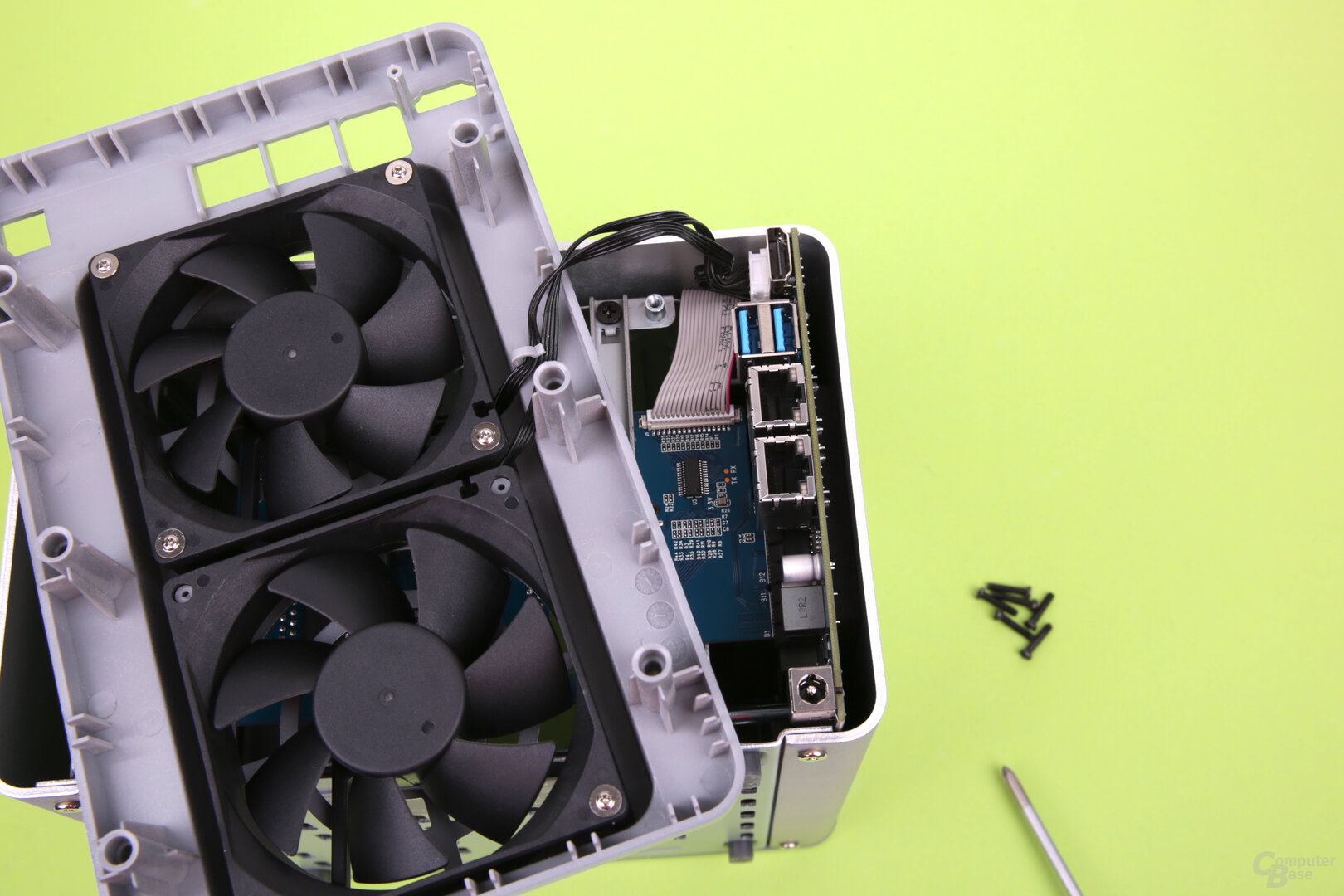 TerraMaster F4-423
TerraMaster F4-423Windows via USB stick
The F4-423 also has a USB-A port with the ROM for the NAS inside. This can be replaced by the user, which means that Windows can also be installed on the new model in order to make a mini PC out of the NAS. A bootable USB stick with the Windows installation is required for this, Windows can then be installed on a drive in the NAS. Thanks to the HDMI interface, you can easily connect a monitor and carry out the installation. The other ports can also be used to connect peripherals to the system. However, it can be more than the factory-installed 4 GB of RAM, in particular, in order to speed up Windows a bit. With the VirtualBox package available in TOS, Linux or Windows virtual machines can also be run on the NAS without forgoing the actual function as a NAS.
Commissioning and software of the TerraMaster F4-423
As mentioned at the beginning, TOS 4 is still used for the most part in the test. The final version of TOS 5 was published shortly before the test report was completed, which is why it is only touched upon and checked in the benchmarks to see whether there are significant performance differences due to the new operating system version. After up to four hard drives and up to two M.2 SSDs have been inserted into the system, it is connected to the power supply unit and at least one network connection to the network for commissioning.
 TerraMaster F4-423: Screwless Drive Frame
TerraMaster F4-423: Screwless Drive Frame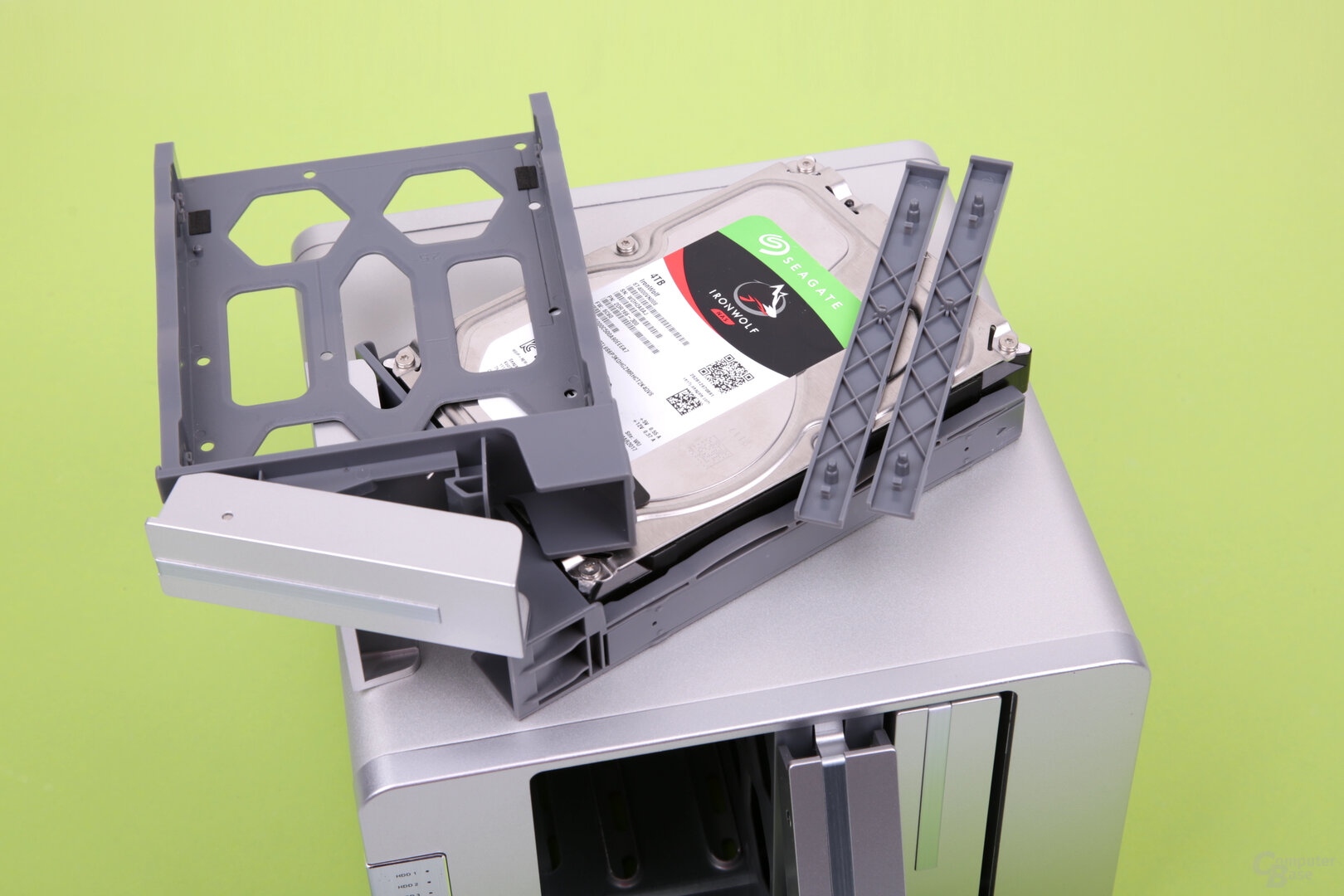 TerraMaster F4-423: Screwless Drive Frame
TerraMaster F4-423: Screwless Drive FrameSetup via web interface
There are now two options for setup. The user can either search for the system in the network using TerraMaster's TNAS software, which is available for Windows and macOS, or open the web interface directly in the browser using the URL tnas.local.
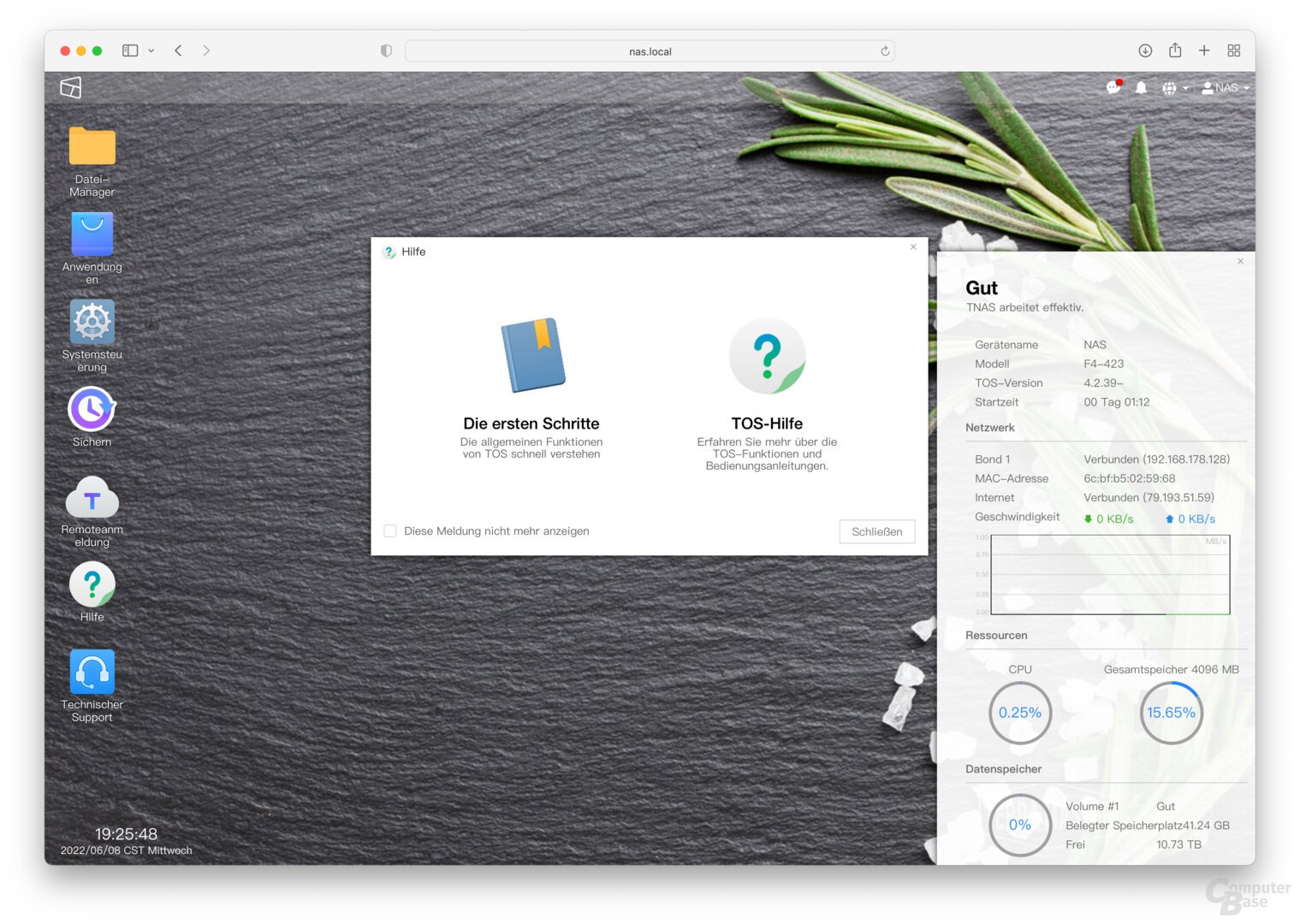 TerraMaster TOS 4 on the F4-423
TerraMaster TOS 4 on the F4-423RAID level and btrfs instead of ext4
During setup, the user must decide whether and which RAID array he wants to use, depending on the number of drives used – they can all be set up as individual drives. When using four drives, RAID 5 + hot spare, RAID 6 or RAID 10 can be selected in addition to RAID 0, RAID 1 and RAID 5. A RAID 5 with three drives and another drive as a single drive or two RAID 1 with two drives each can also be implemented.
In addition to the ext4 file format, which is mandatory for a Linux-based NAS operating system such as TOS, TerraMaster again offers btrfs as a file system. The copy-on-write file system has an implemented integrity check that increases data security and prevents data corruption. In addition, btrfs allows snapshots to be created so that deleted data can be recovered. Which RAID configuration is used is irrelevant for the available functions.
-
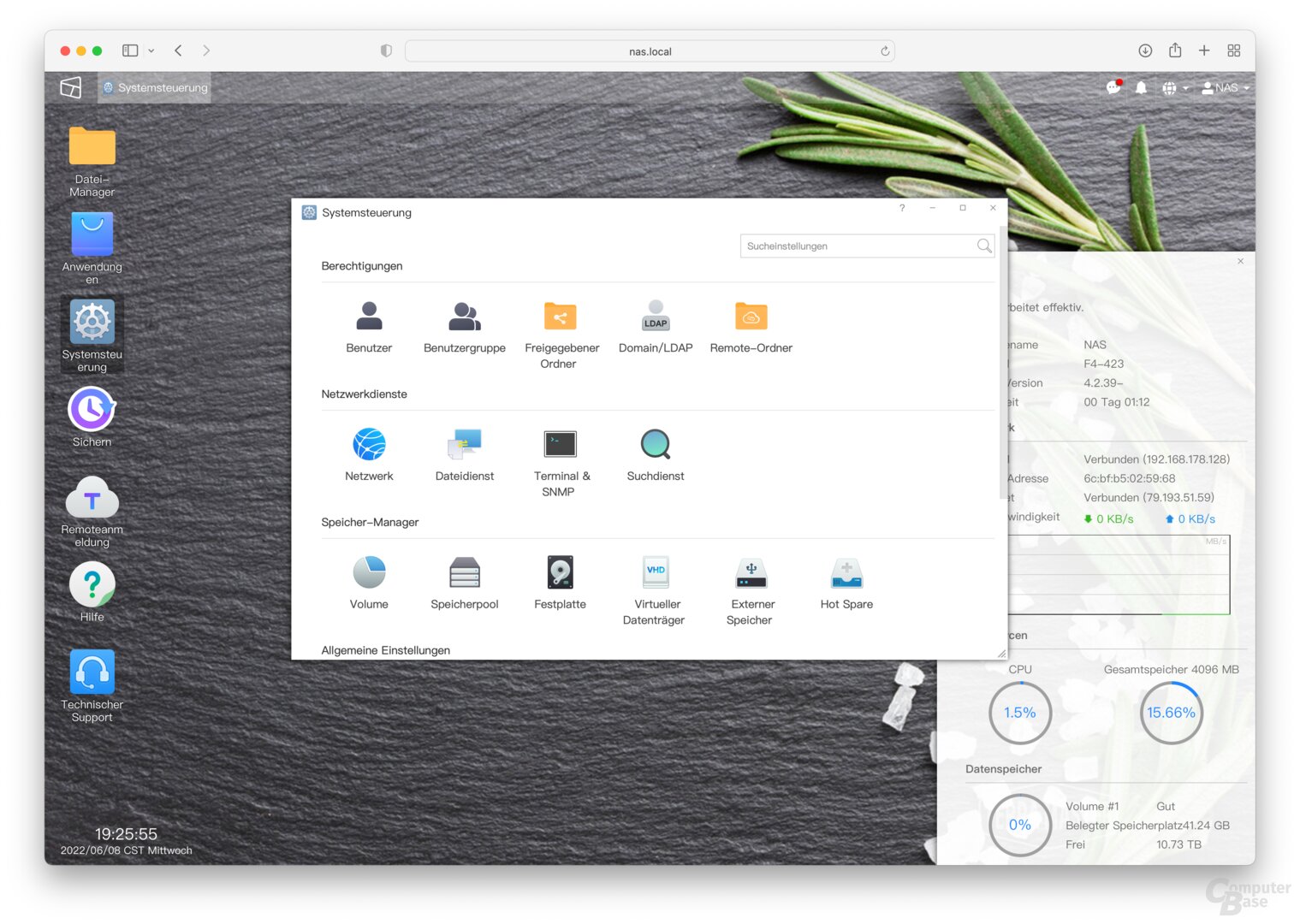 TerraMaster TOS 4 on the F4-423
TerraMaster TOS 4 on the F4-423
Image 1 of 19

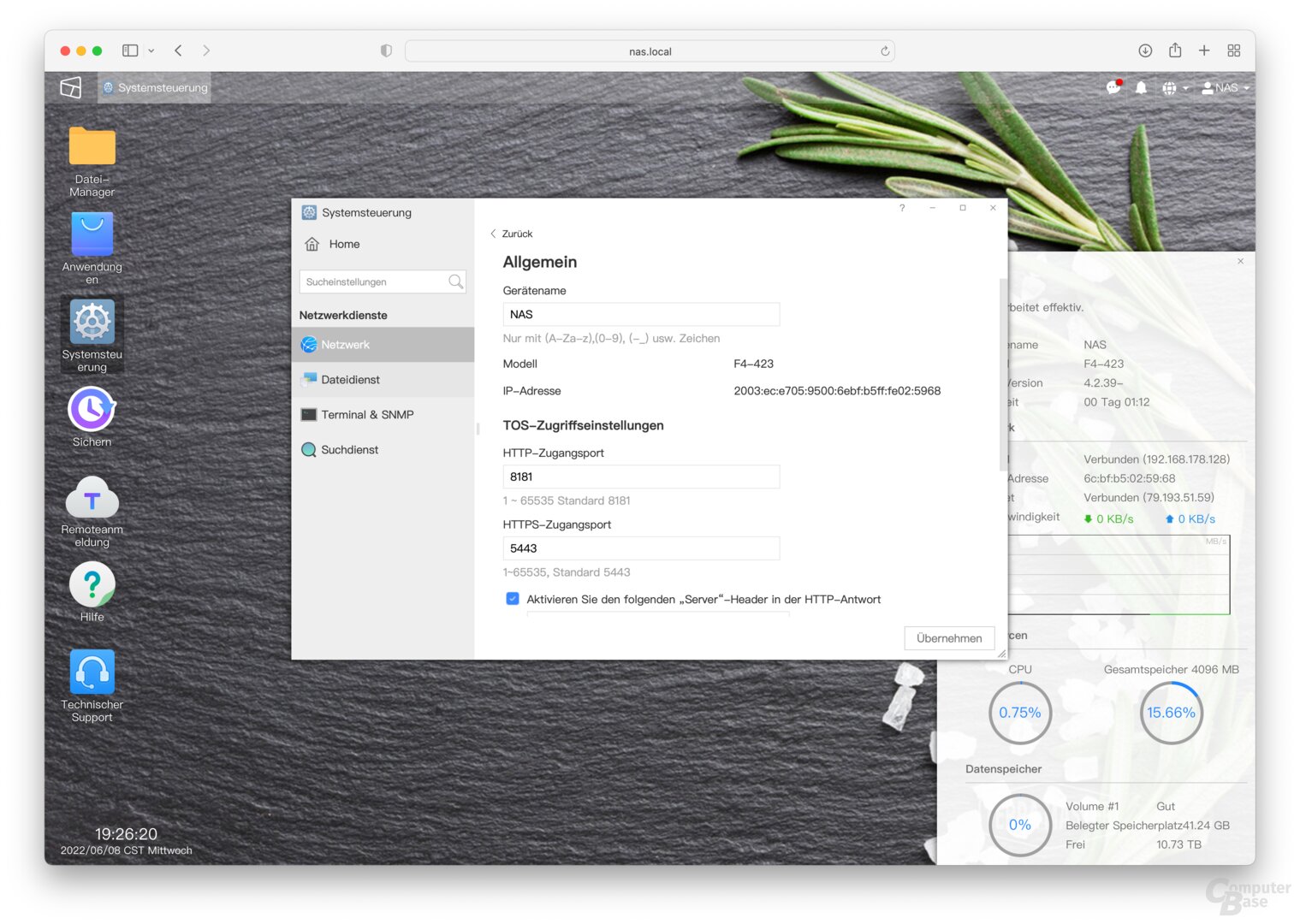

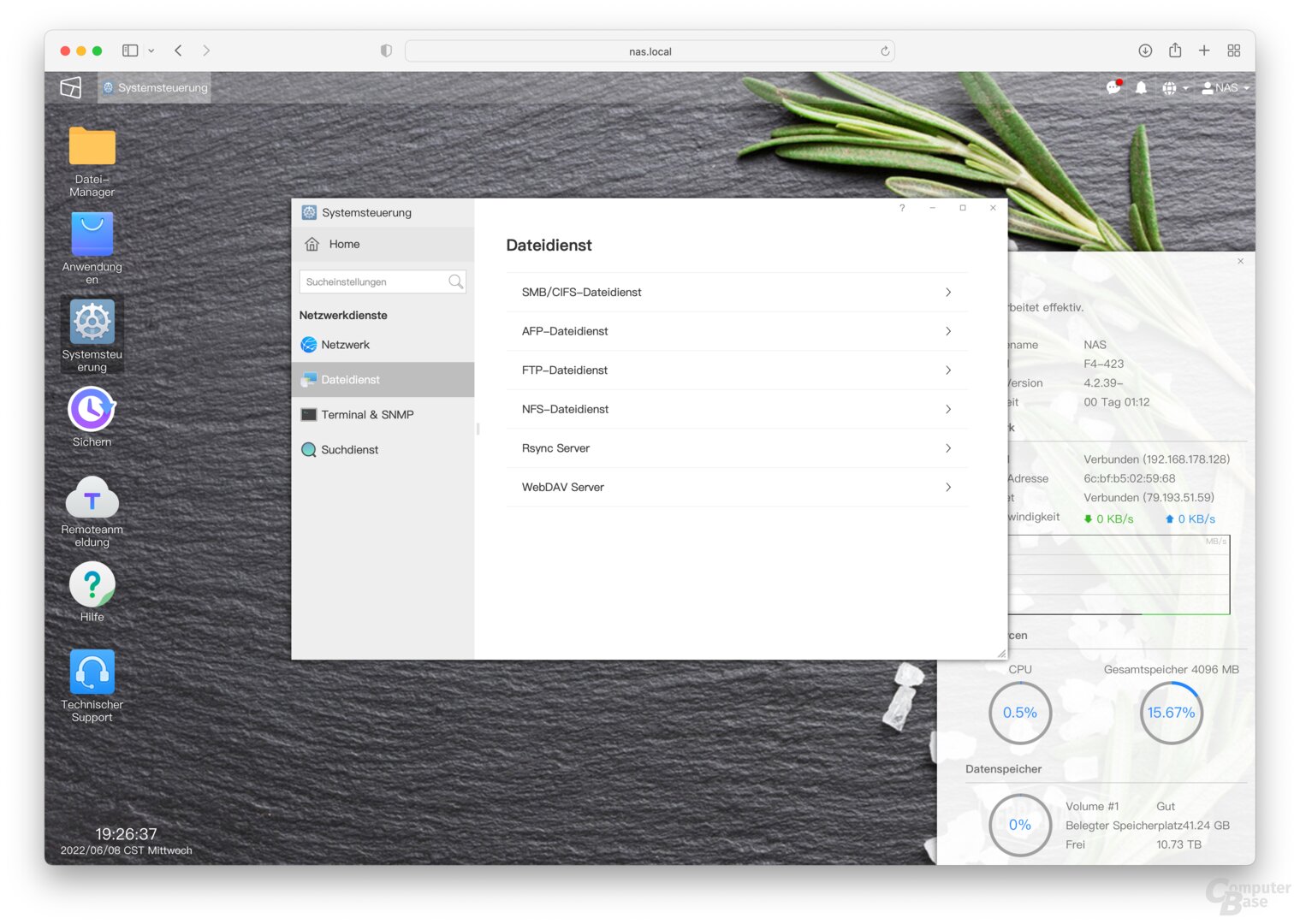

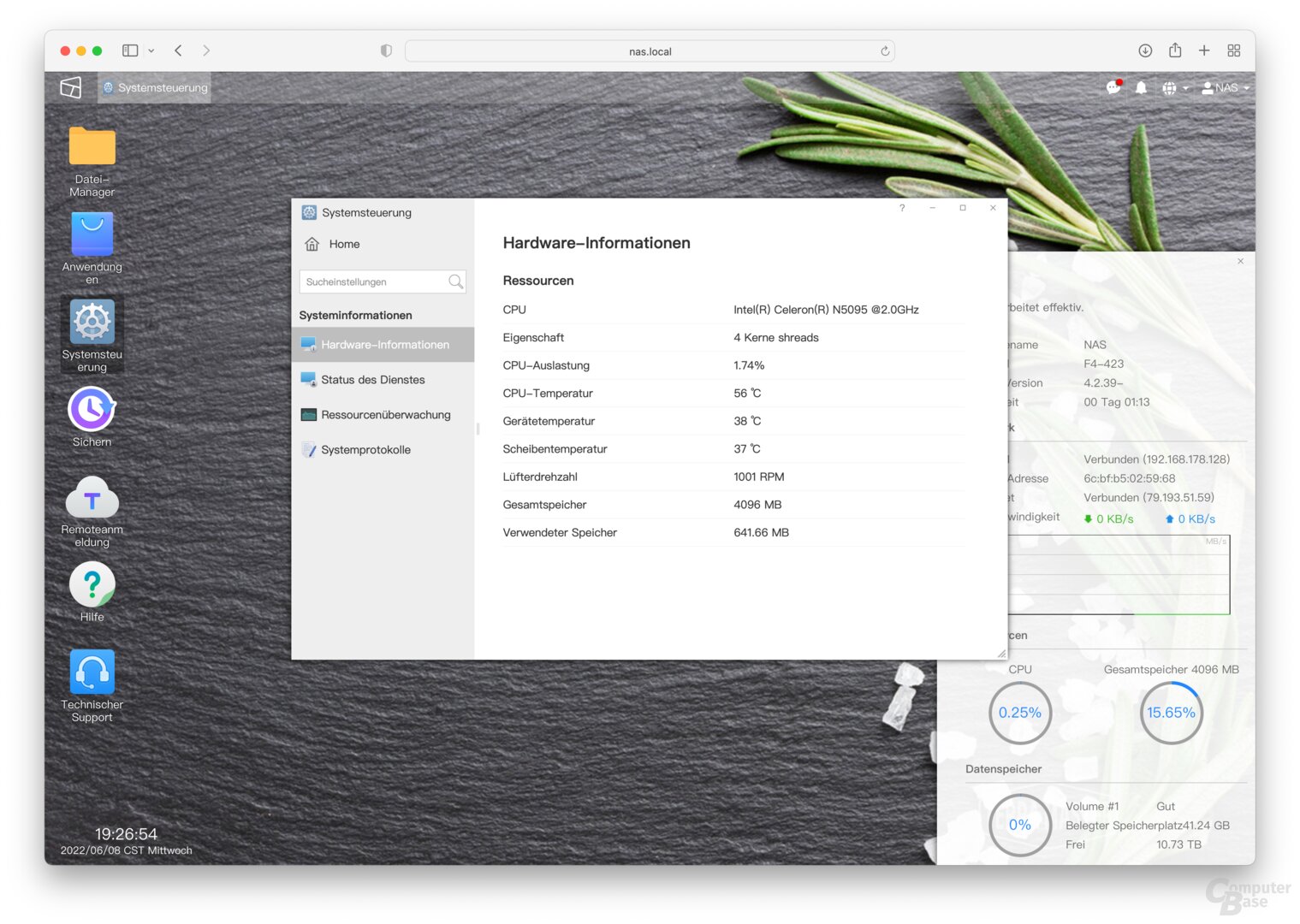
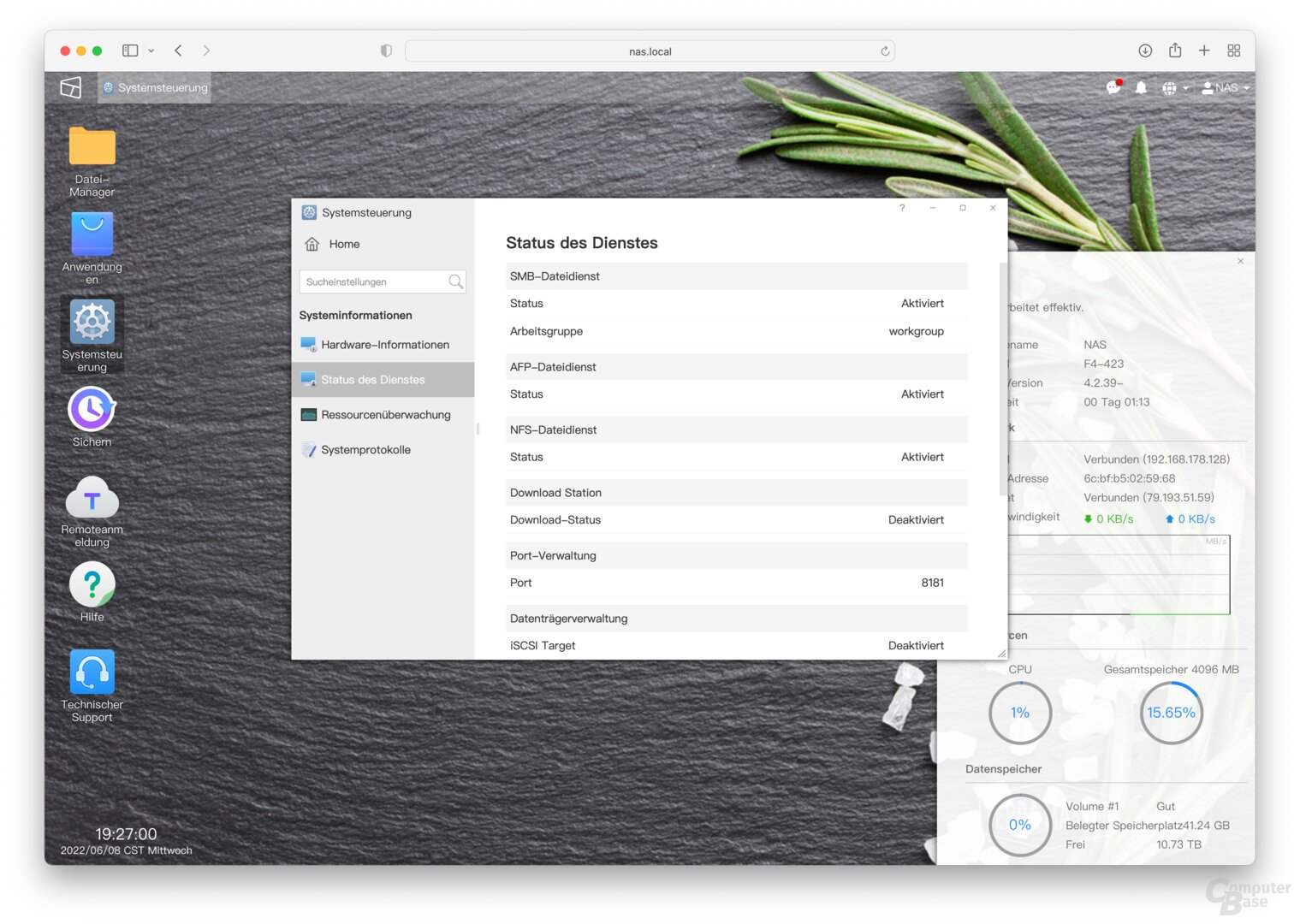
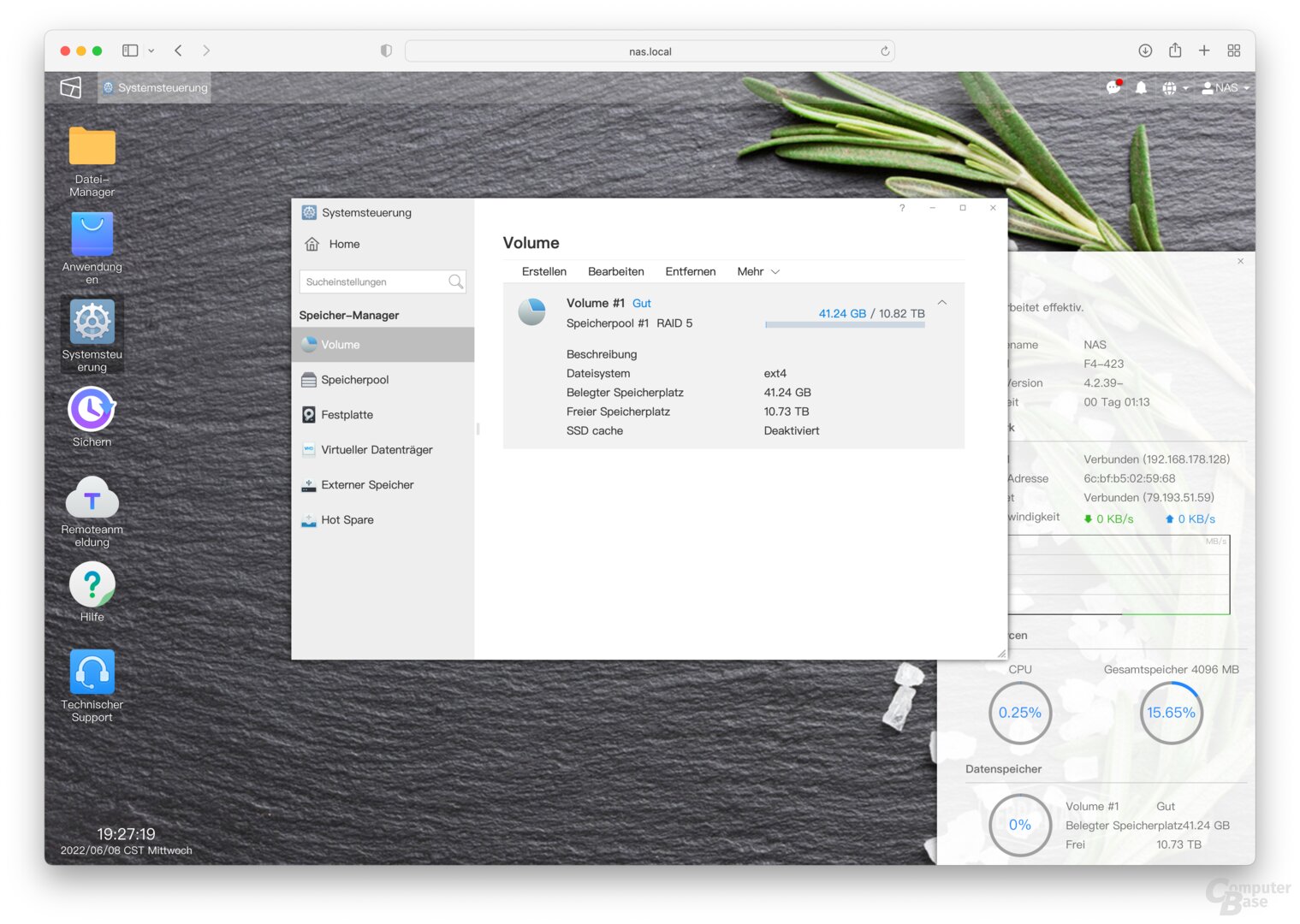
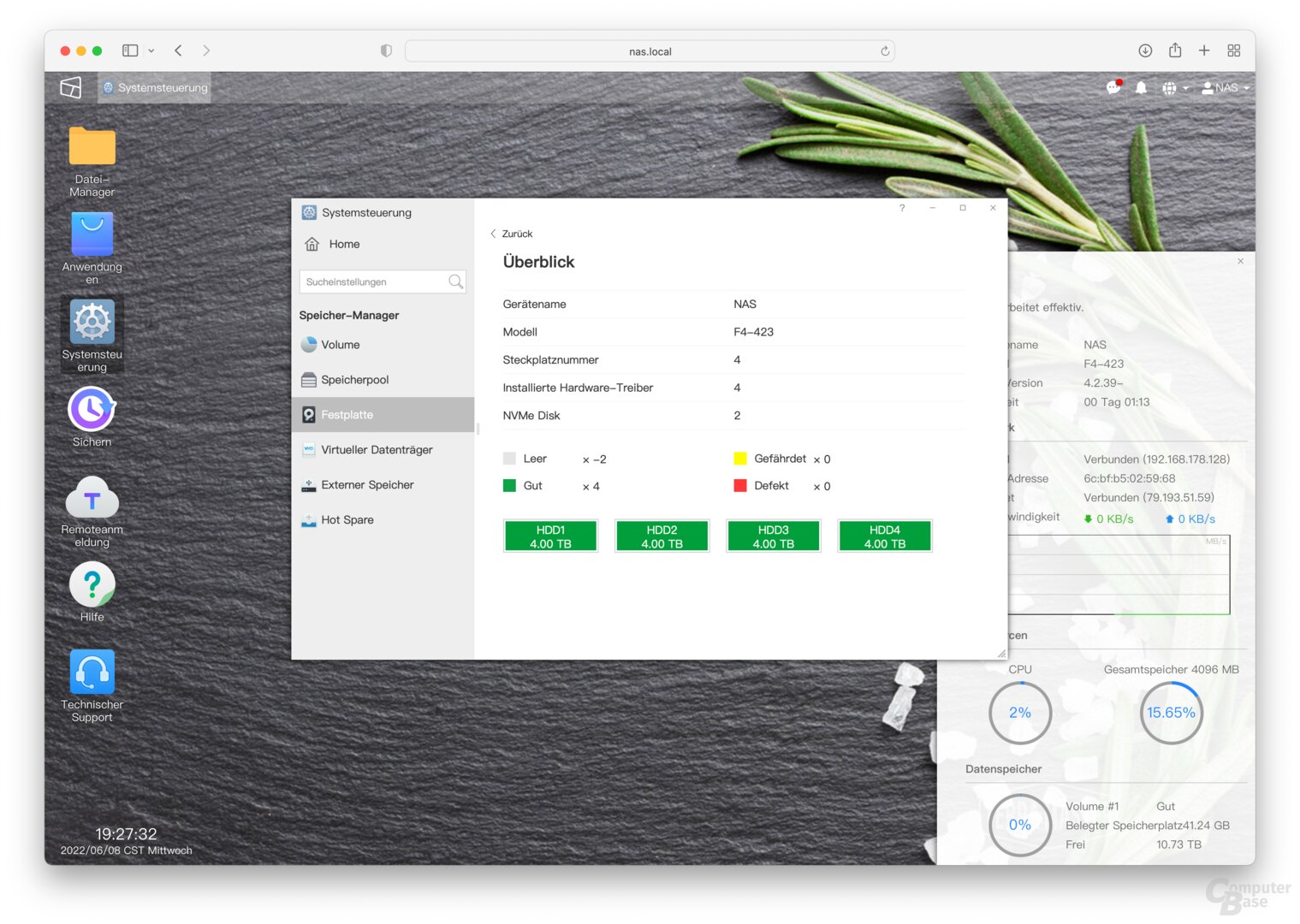

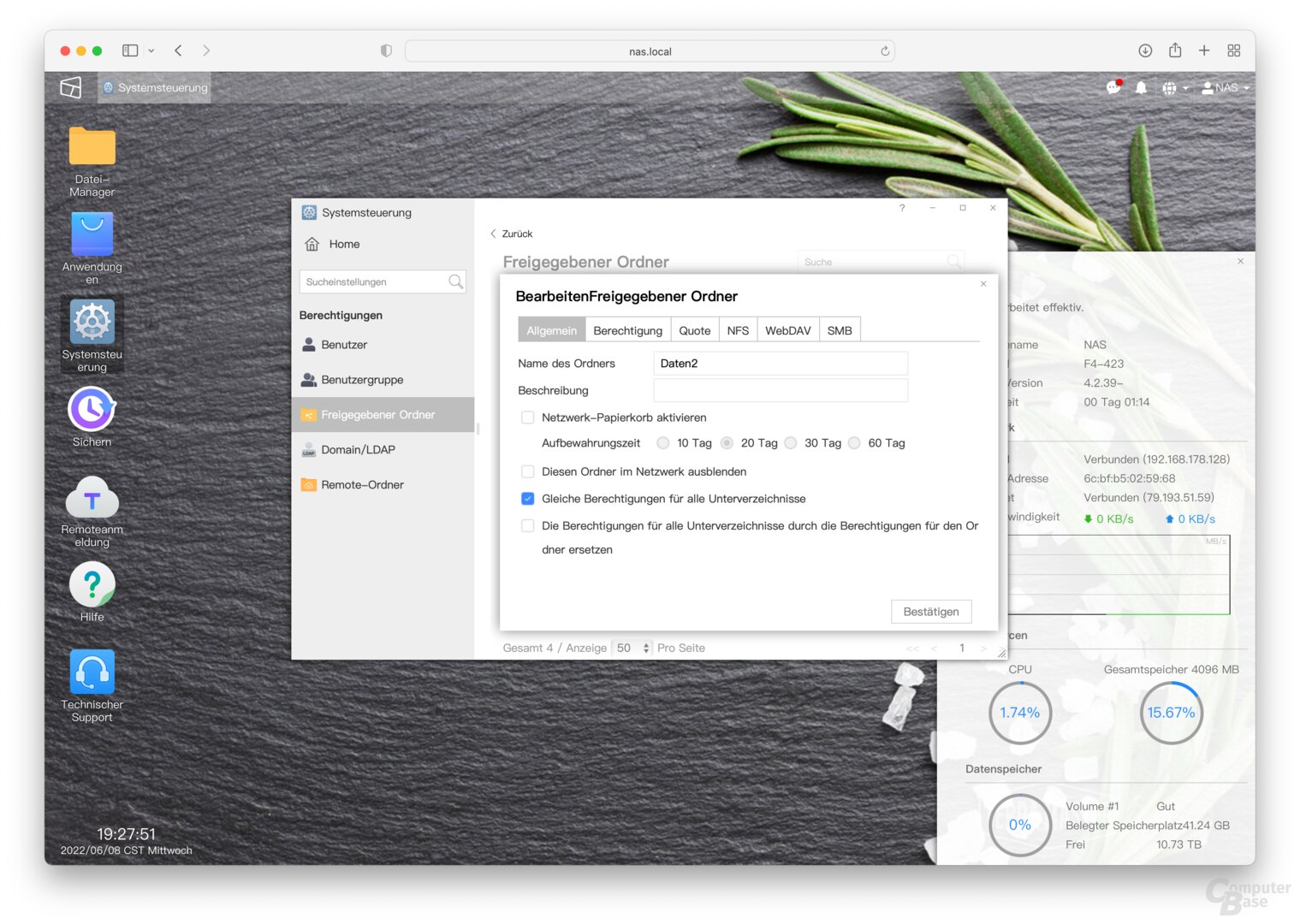

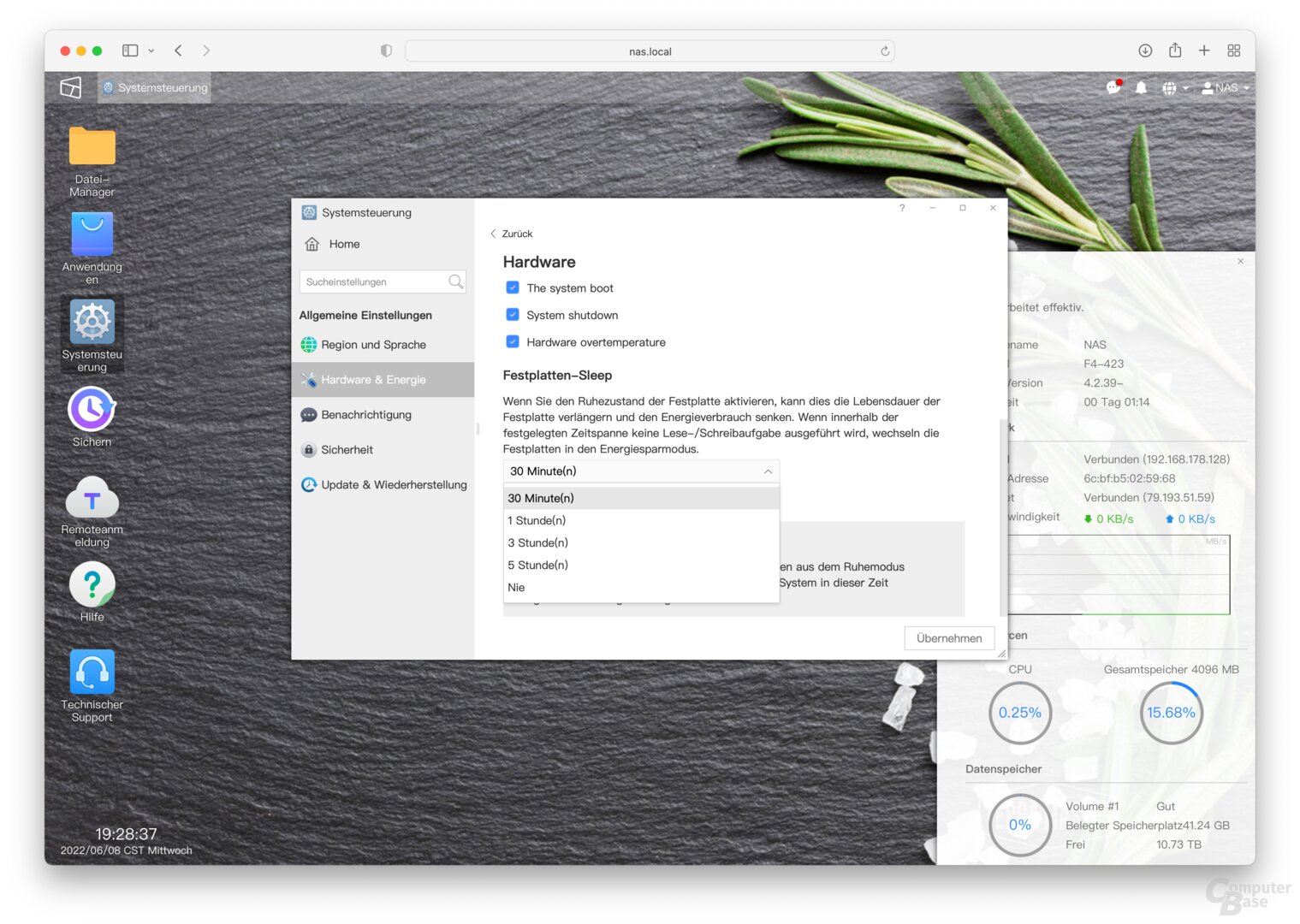

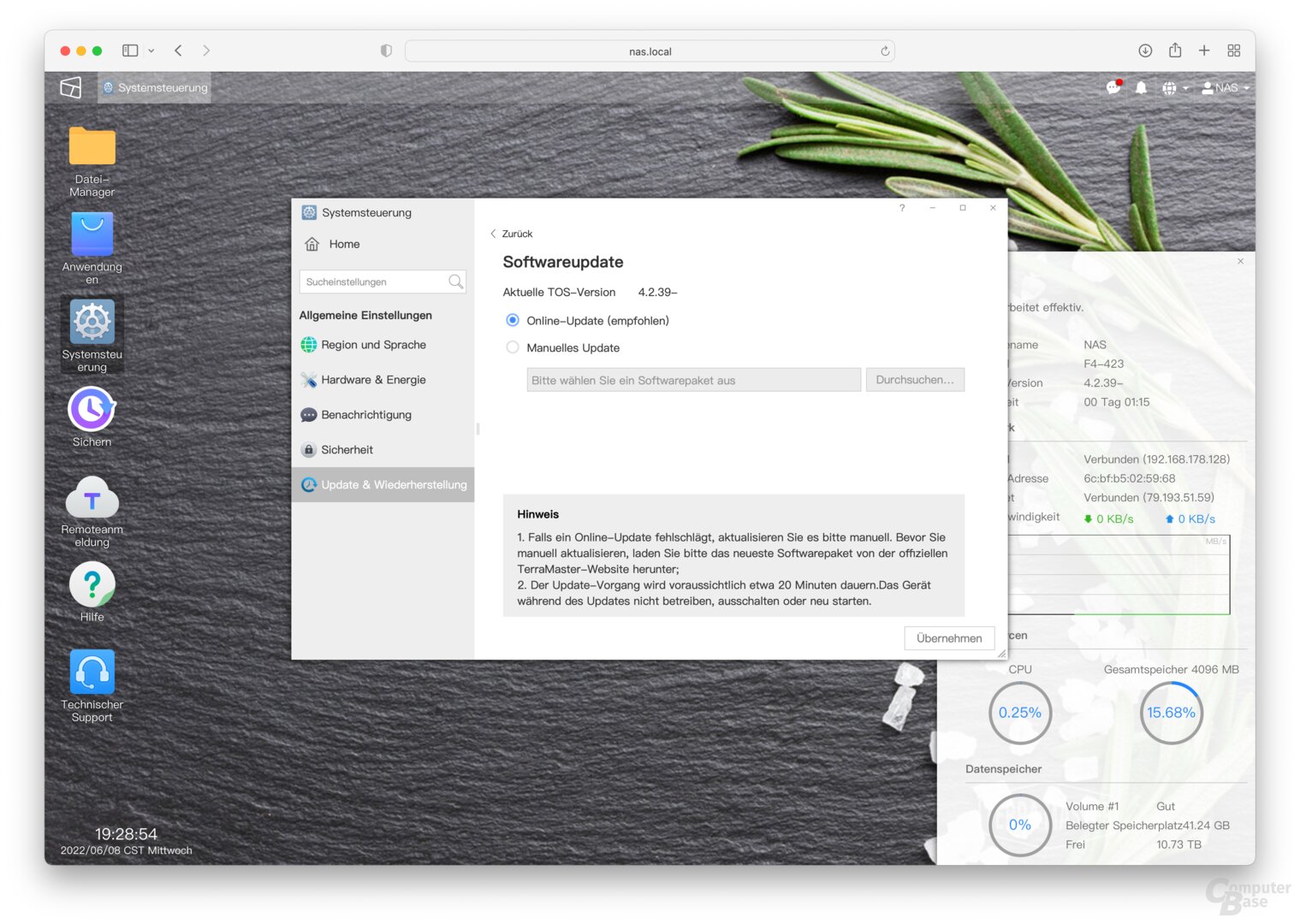
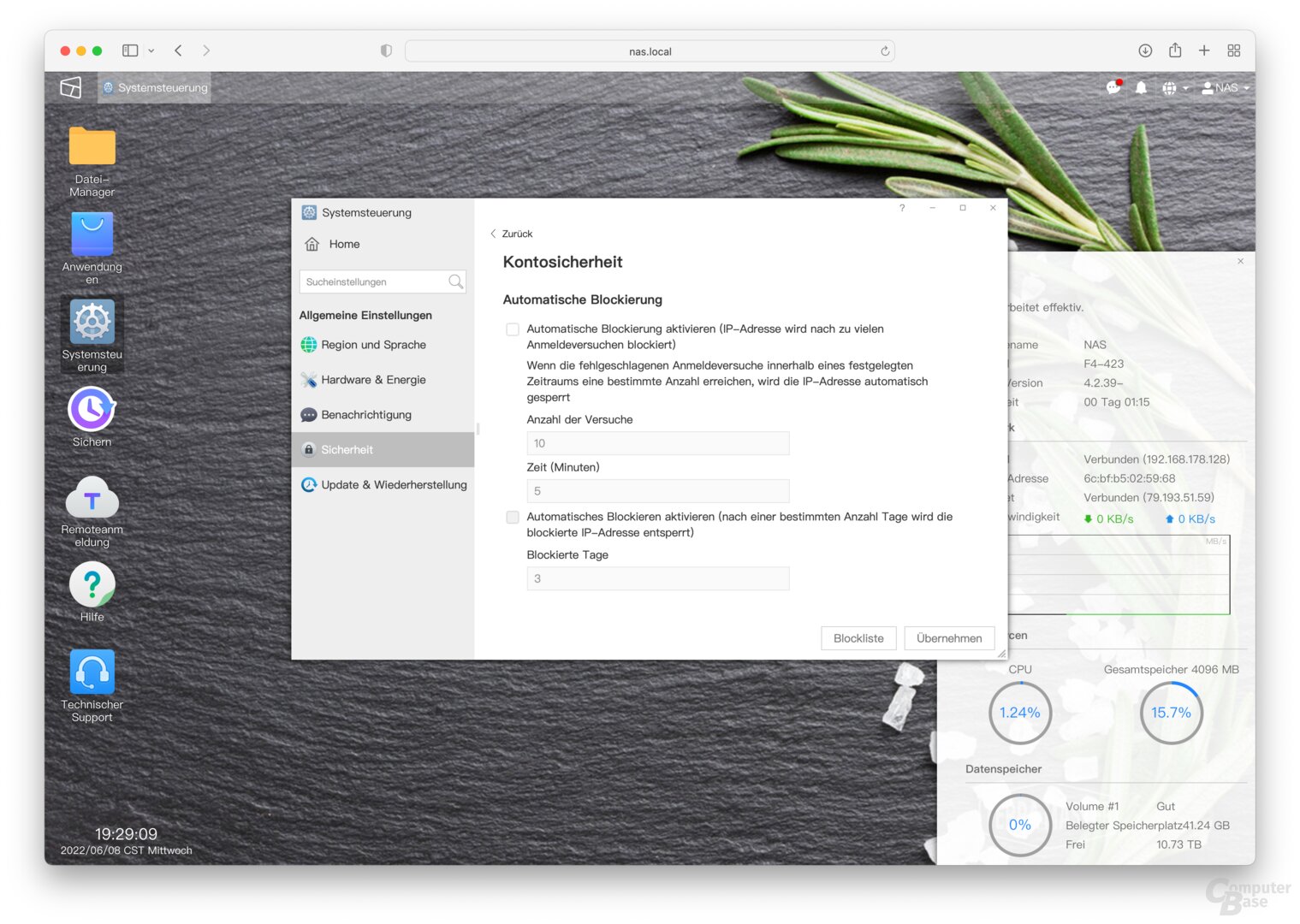
TerraMaster TOS 4 on the F4-423
Many functions, old software versions
The basic structure of the TOS user interface is similar to that of QNAP or Synology, although TerraMaster has also recently made visual progress and made the interface more attractive for users. Nothing has changed in the overall somewhat more text-heavy orientation of the menus, which the user first has to penetrate in order to get an overview of the functions. The QNAP and Synology interfaces are better structured in this regard, although the QNAP system in particular now seems a bit overloaded.
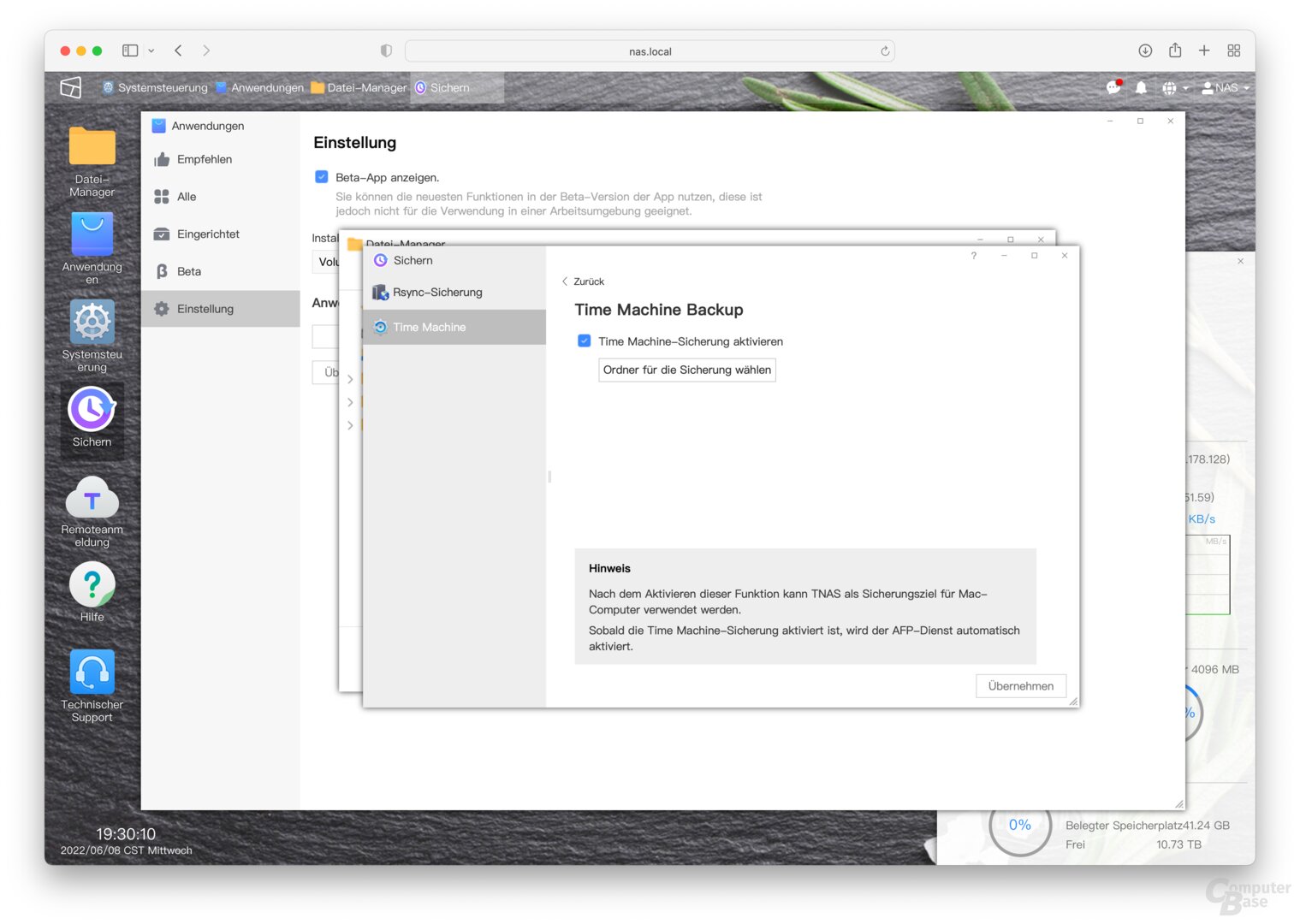

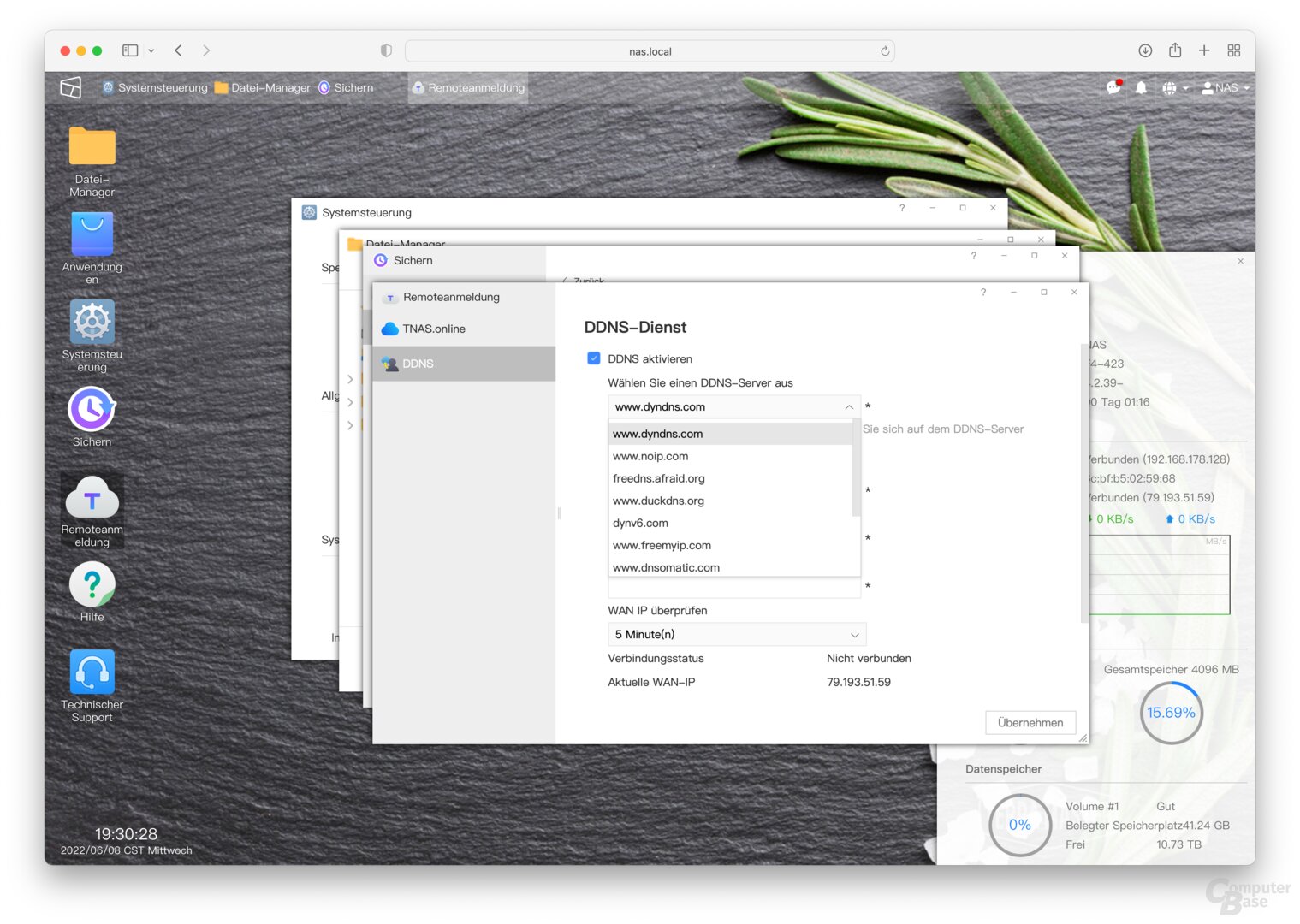
TerraMaster TOS 4 on the F4-423
Some menus are a bit sluggish to use, and TOS 4 is overall a bit slower to respond than Synology's and QNAP's DSM or QTS for both loading and saving settings. Also still not solved is a problem with created and then deleted shared folders. If a previously deleted shared folder is recreated with the same name, the system sometimes refuses to do so, saying that the folder already exists. However, the problem does not always occur and not with every folder. It could not be reliably reproduced, so the cause cannot be identified.
-
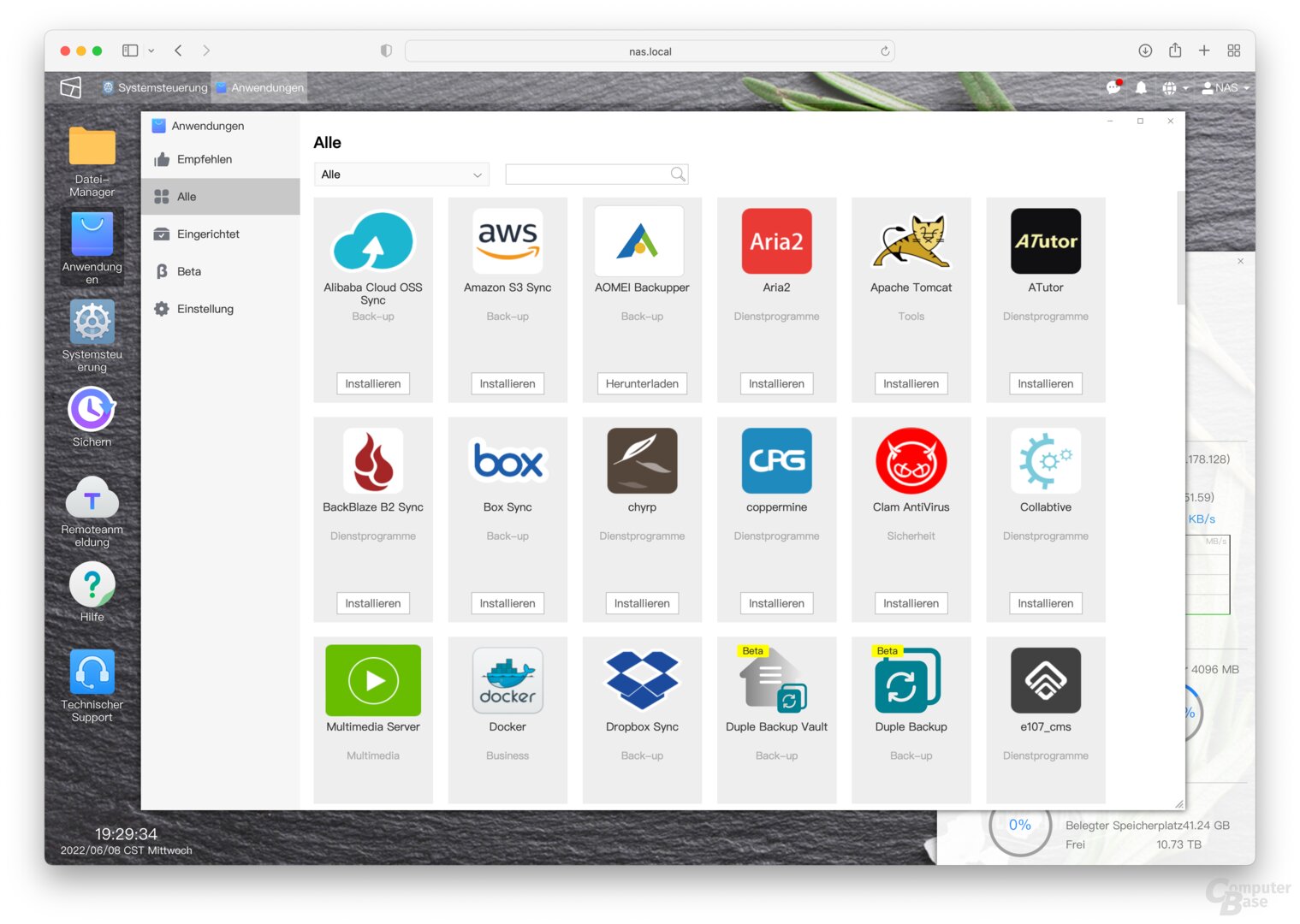 TerraMaster TOS 4 on the F4-423
TerraMaster TOS 4 on the F4-423
Image 1 of 5
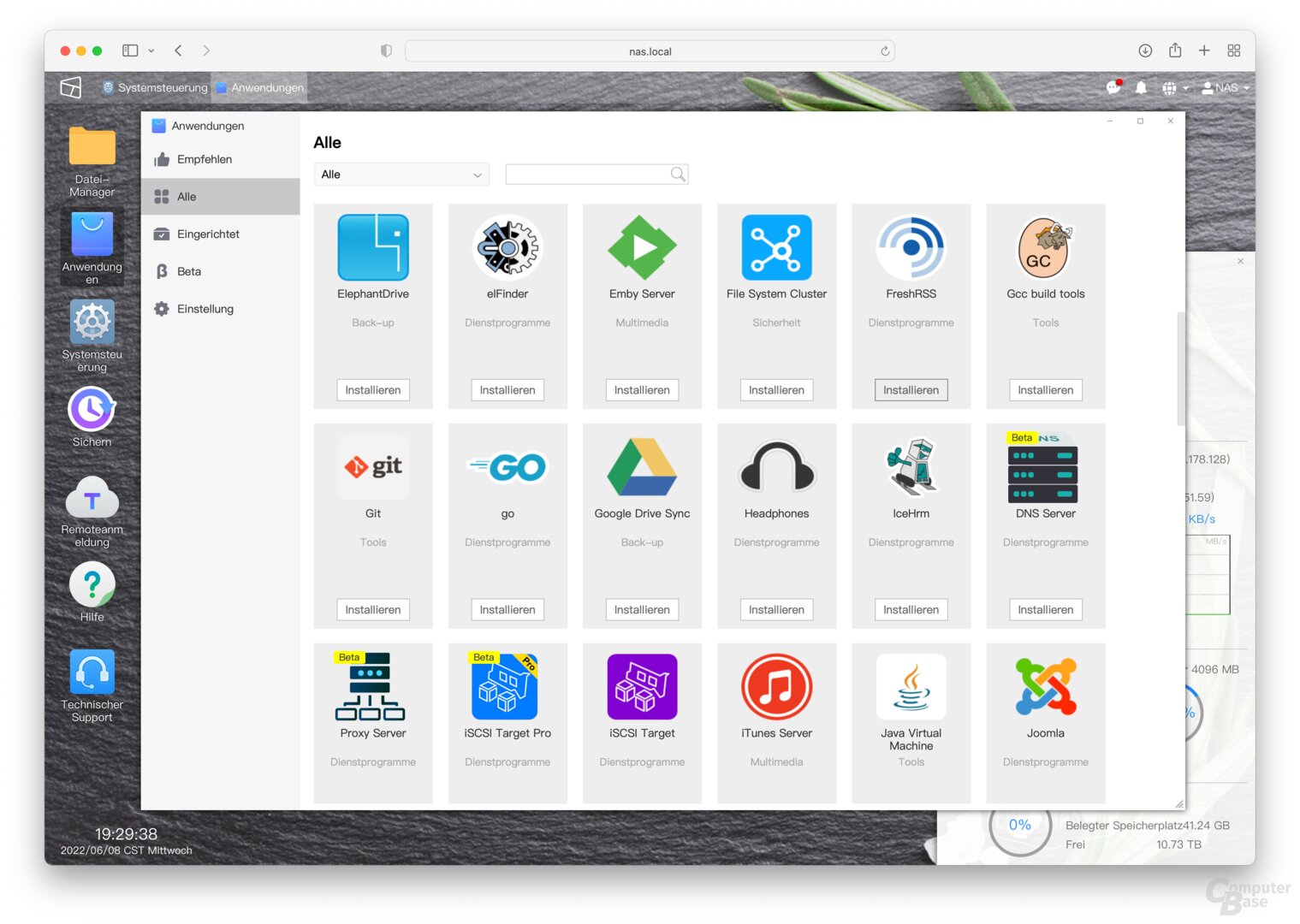

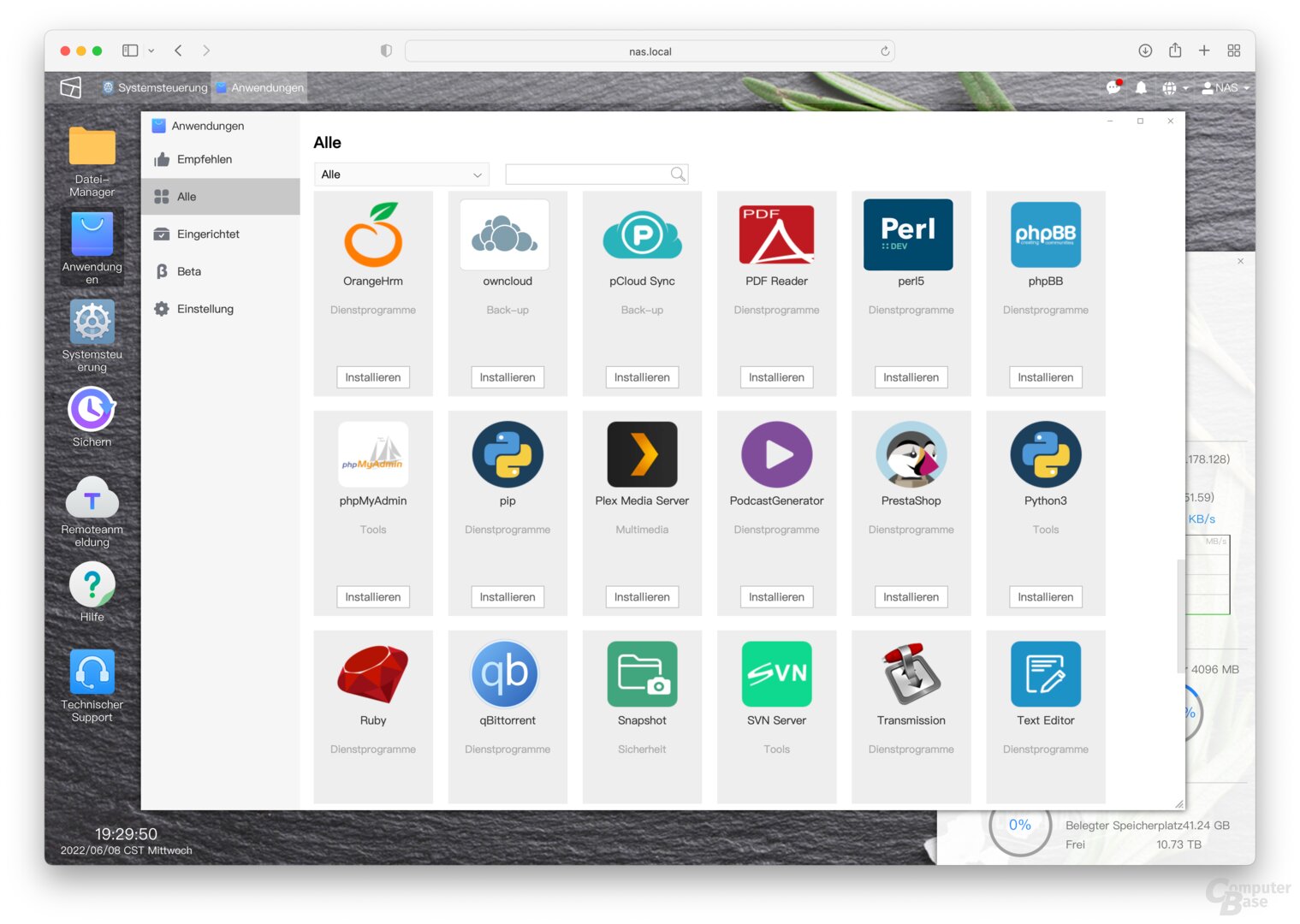

TerraMaster TOS 4 on the F4-423
TerraMaster also offers many of the functions and configuration options that are important in everyday life directly in the system. If you want to use additional functionality, you can install additional software from the interface, which includes applications such as Docker, Git or Python or backup apps for Amazon S3 in addition to the Plex Media Server. However, this confirms once again that the applications do not always reflect the current software status. Extensions like Git (as of November 2021) and Python (as of 2018) lag significantly behind the normal versions. A problem that basically also occurs with the competition.
TOS 5 reacts much faster
The web interface of the new TOS 5 reacts much faster overall, submenus are opened faster, inputs are implemented more quickly and individual sub-items are better structured. In addition, the range of functions has actually increased significantly in some areas. At least in the interface it does not represent the revolution announced by TerraMaster, because visually it is strongly reminiscent of TOS 4. Under the hood, however, much more has happened, even if such banal things as querying the time zone in the manual setup are currently missing , which is why the NAS doesn't tick quite right after the first boot. In addition, no SSD cache could be set up in the test sample with TOS 5, although the NAS correctly recognized the two M.2 drives. It also crunches a little in one place or another.
-
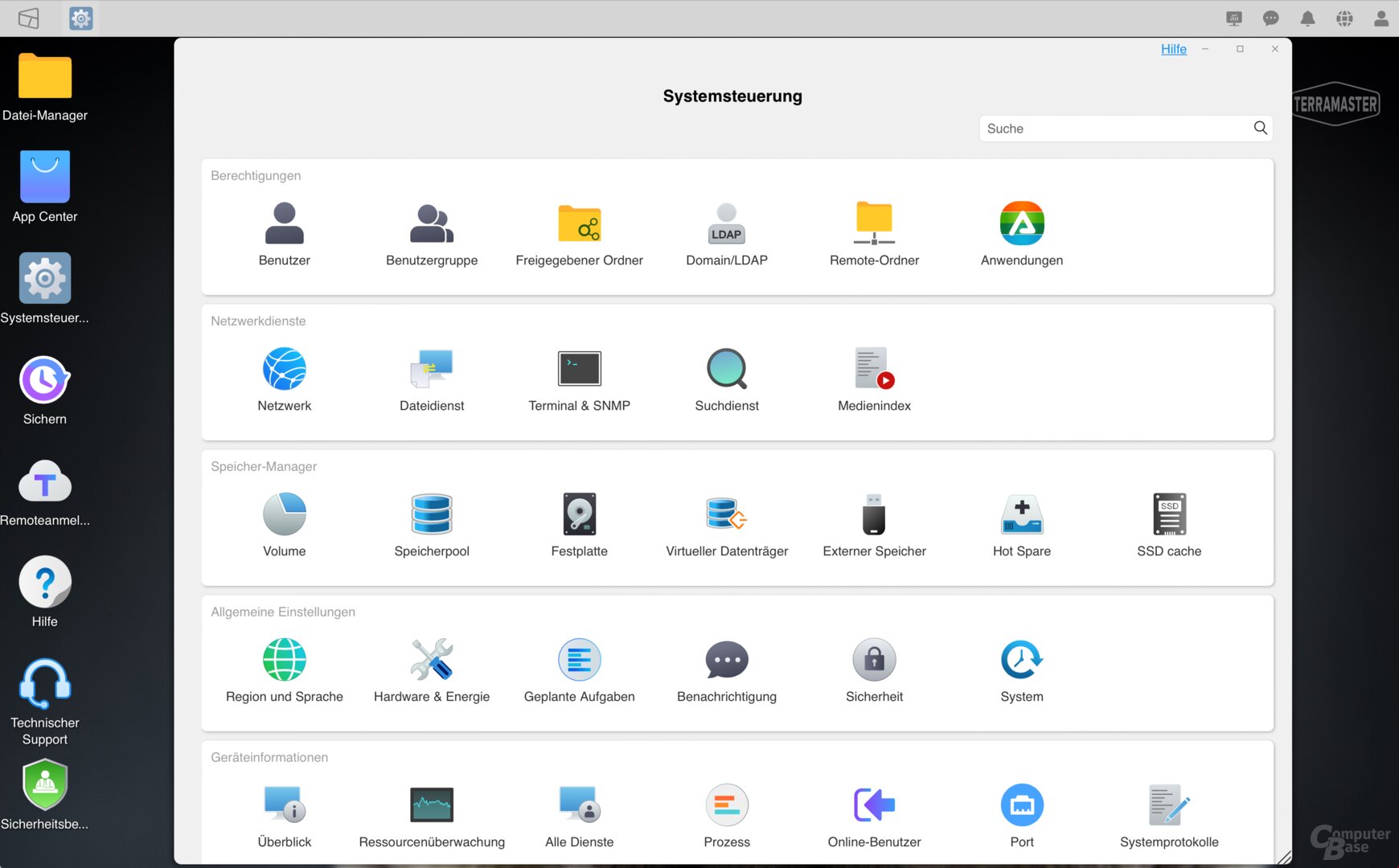 TerraMaster TOS 5 on the F4-423
TerraMaster TOS 5 on the F4-423
Image 1 of 21
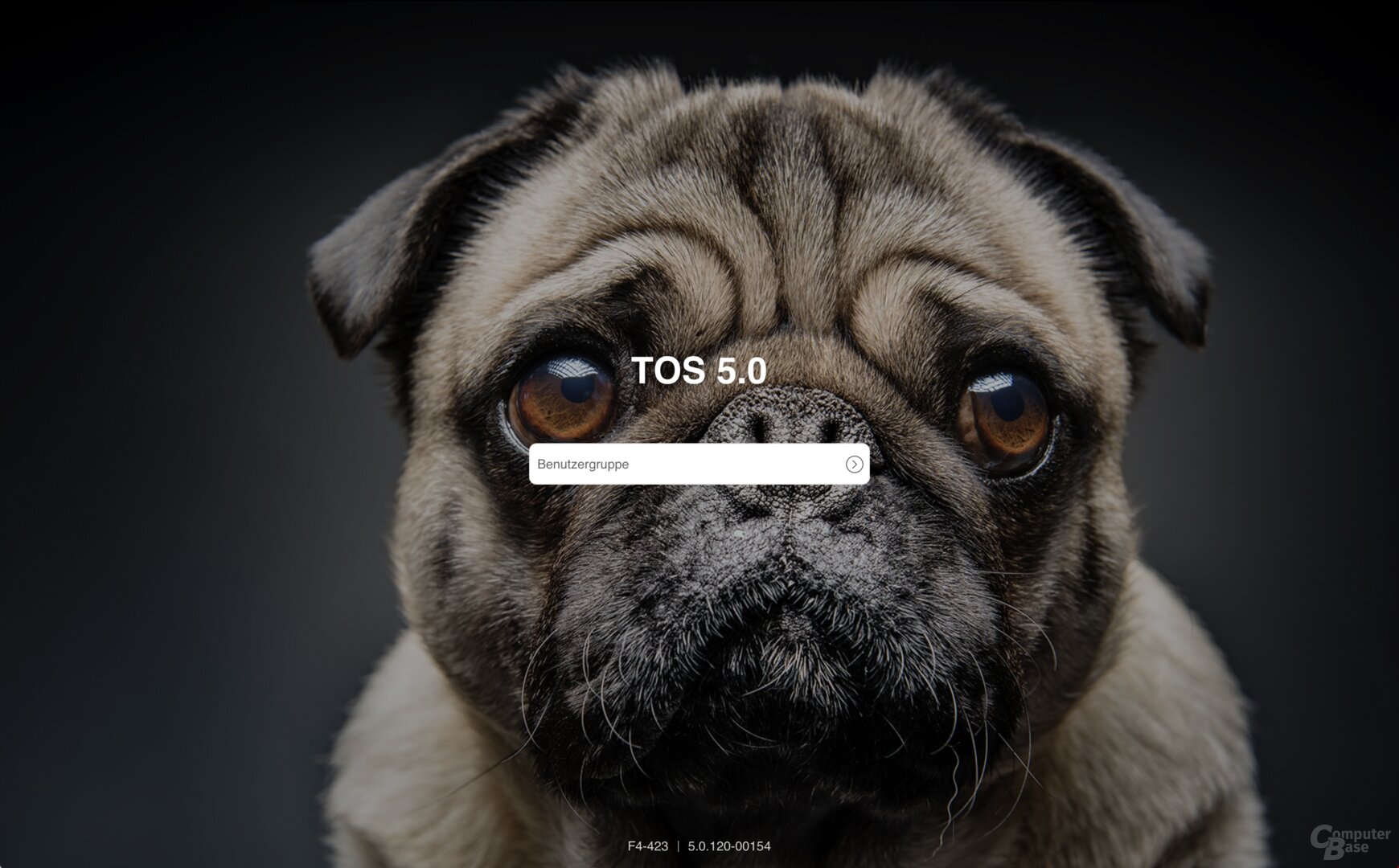
< figure class="thumbs__figure"> 
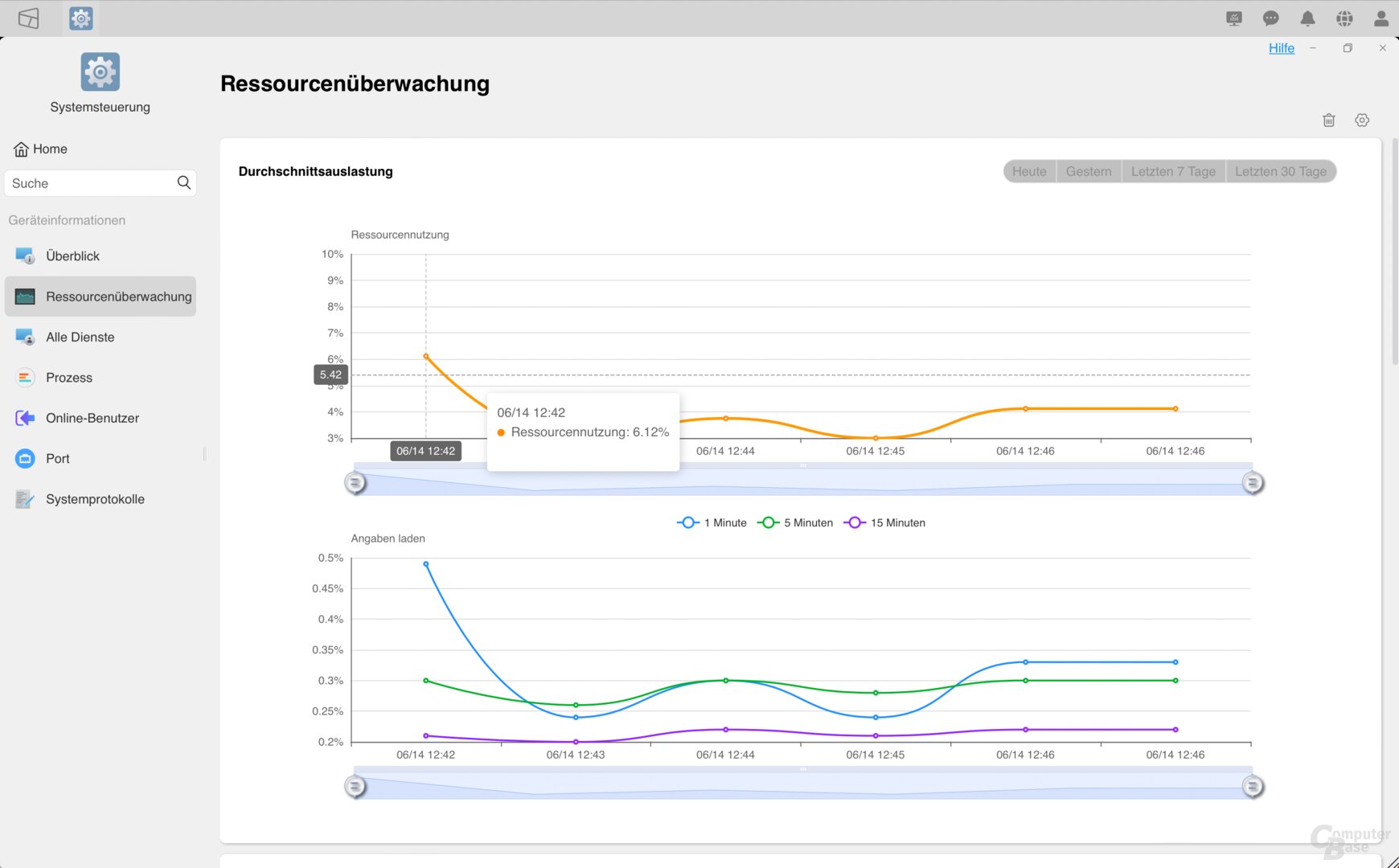
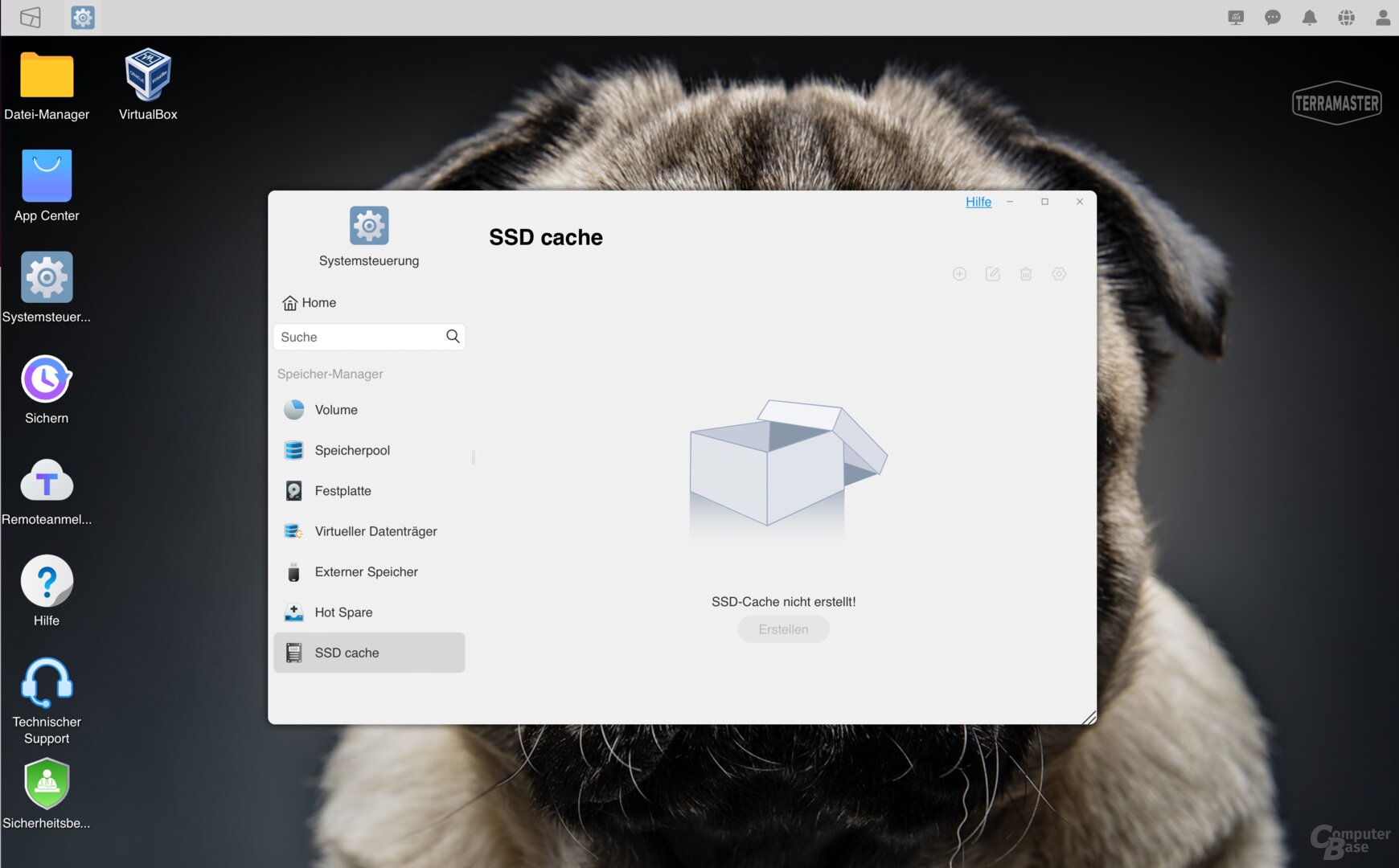
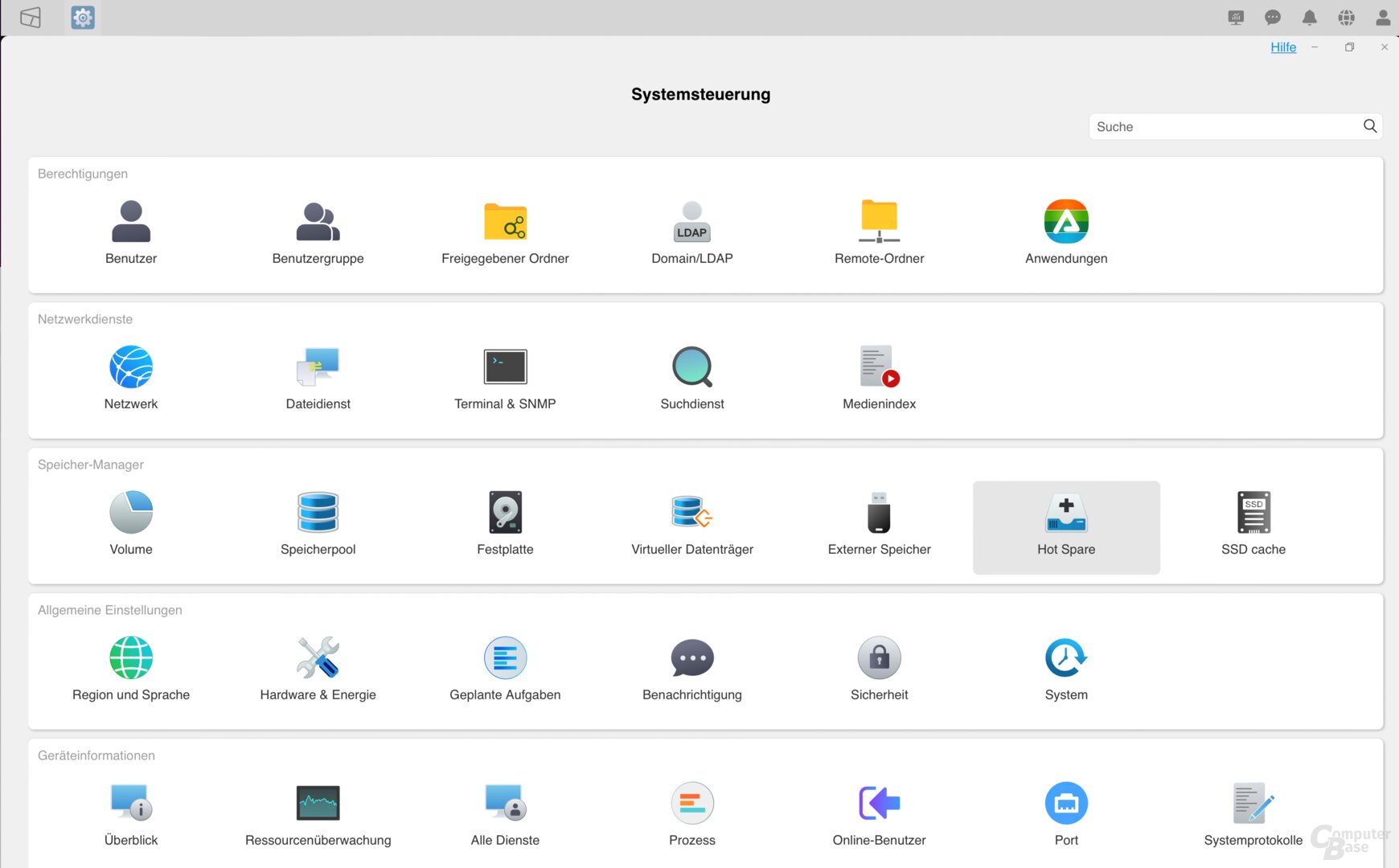

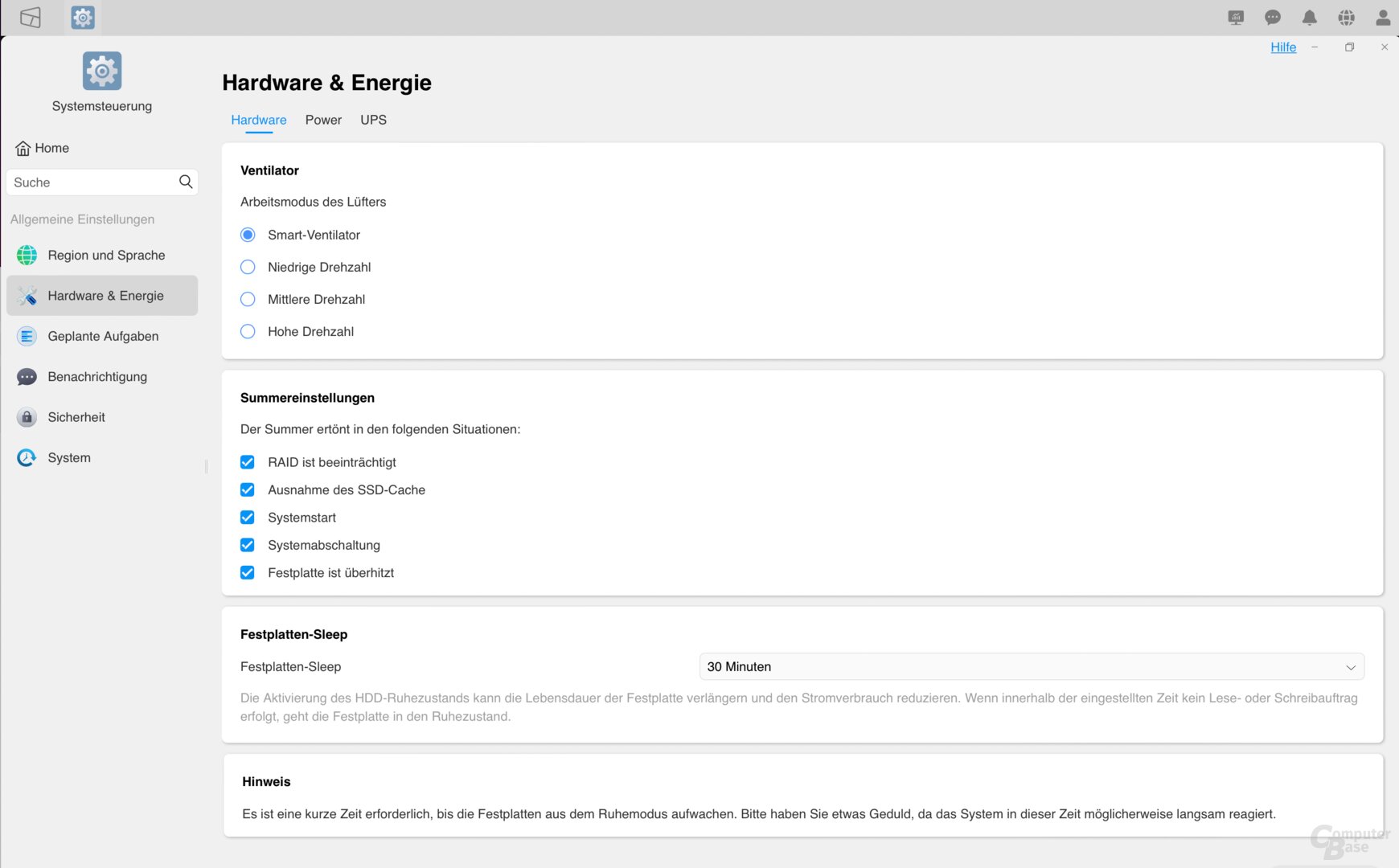
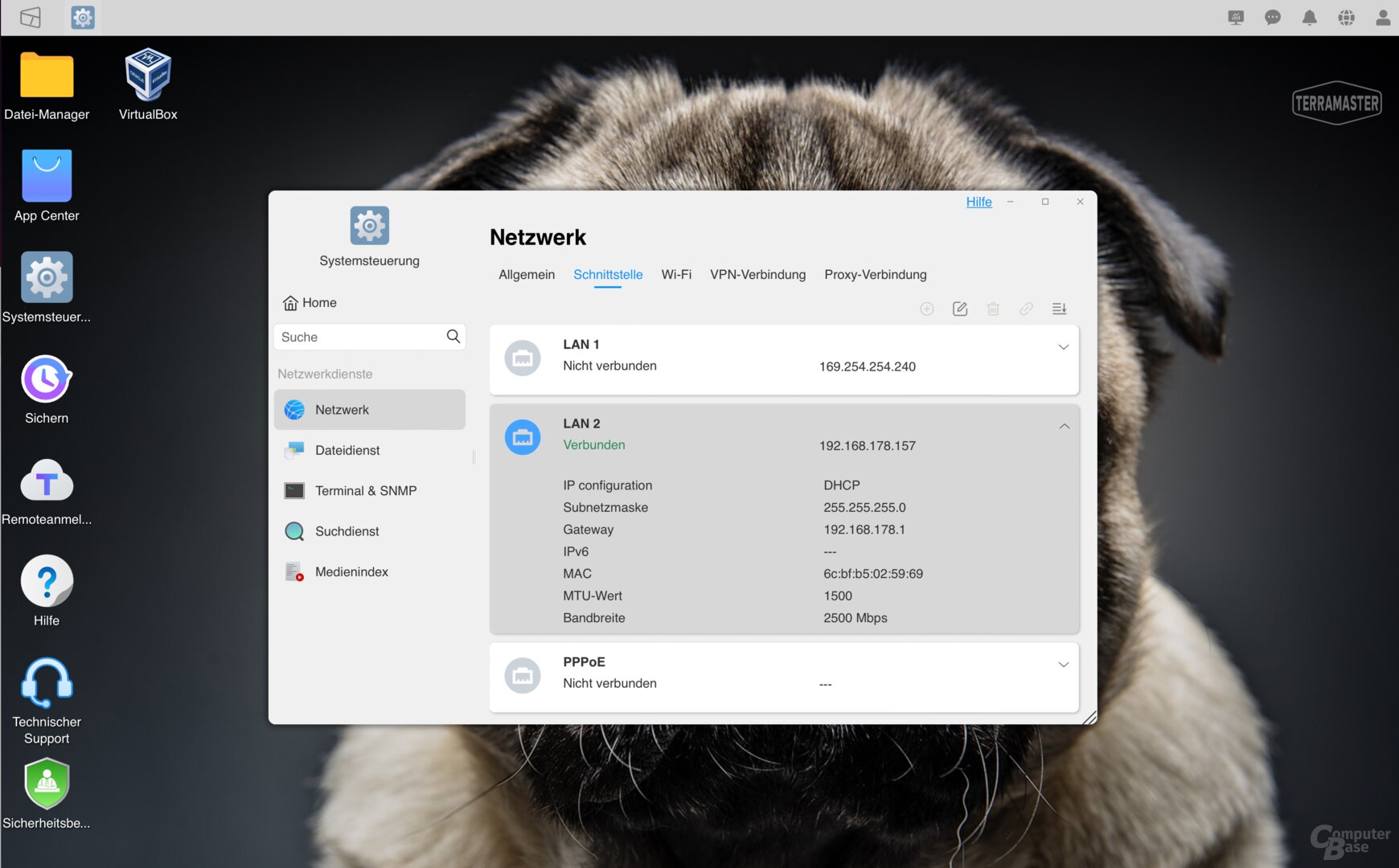
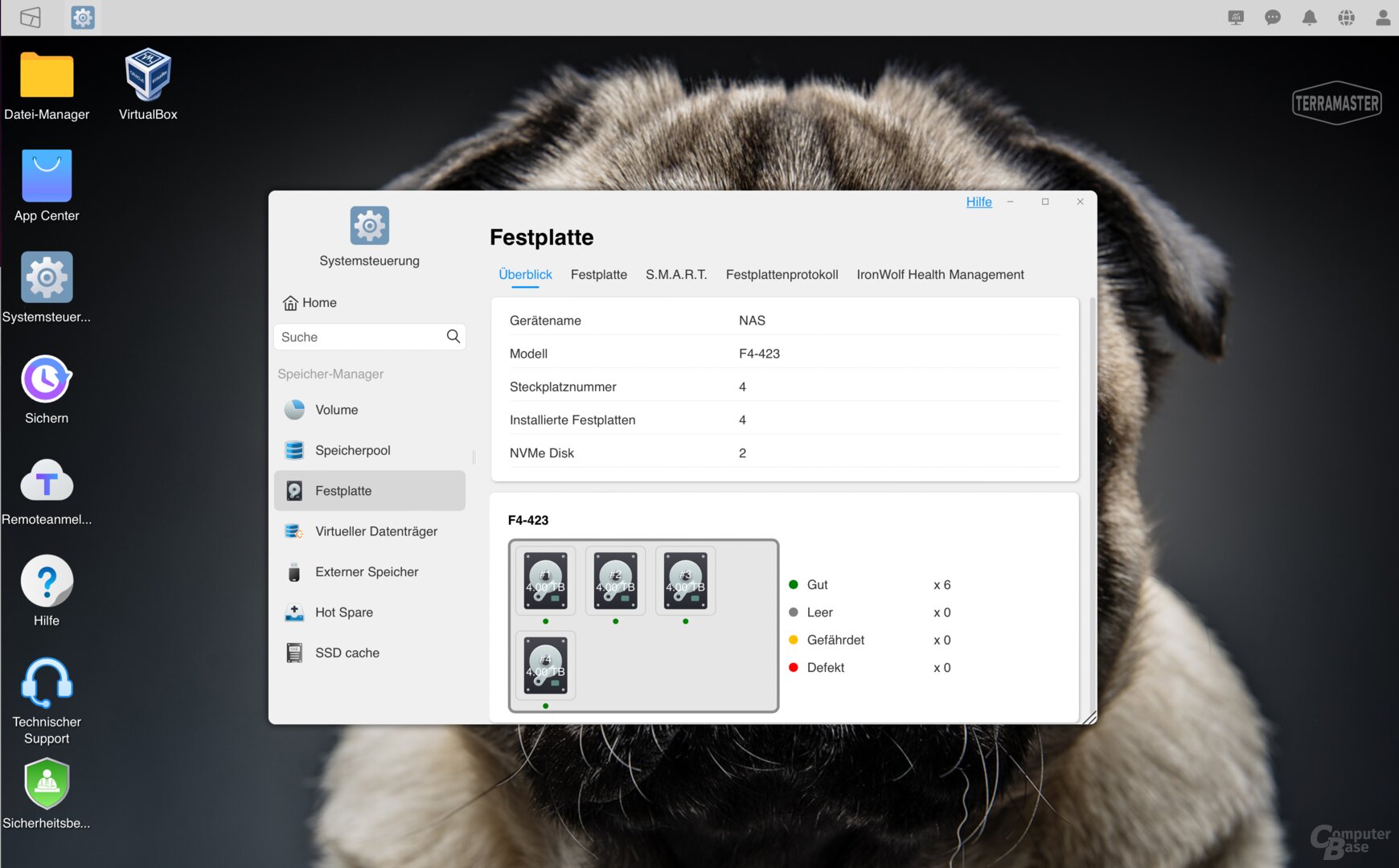
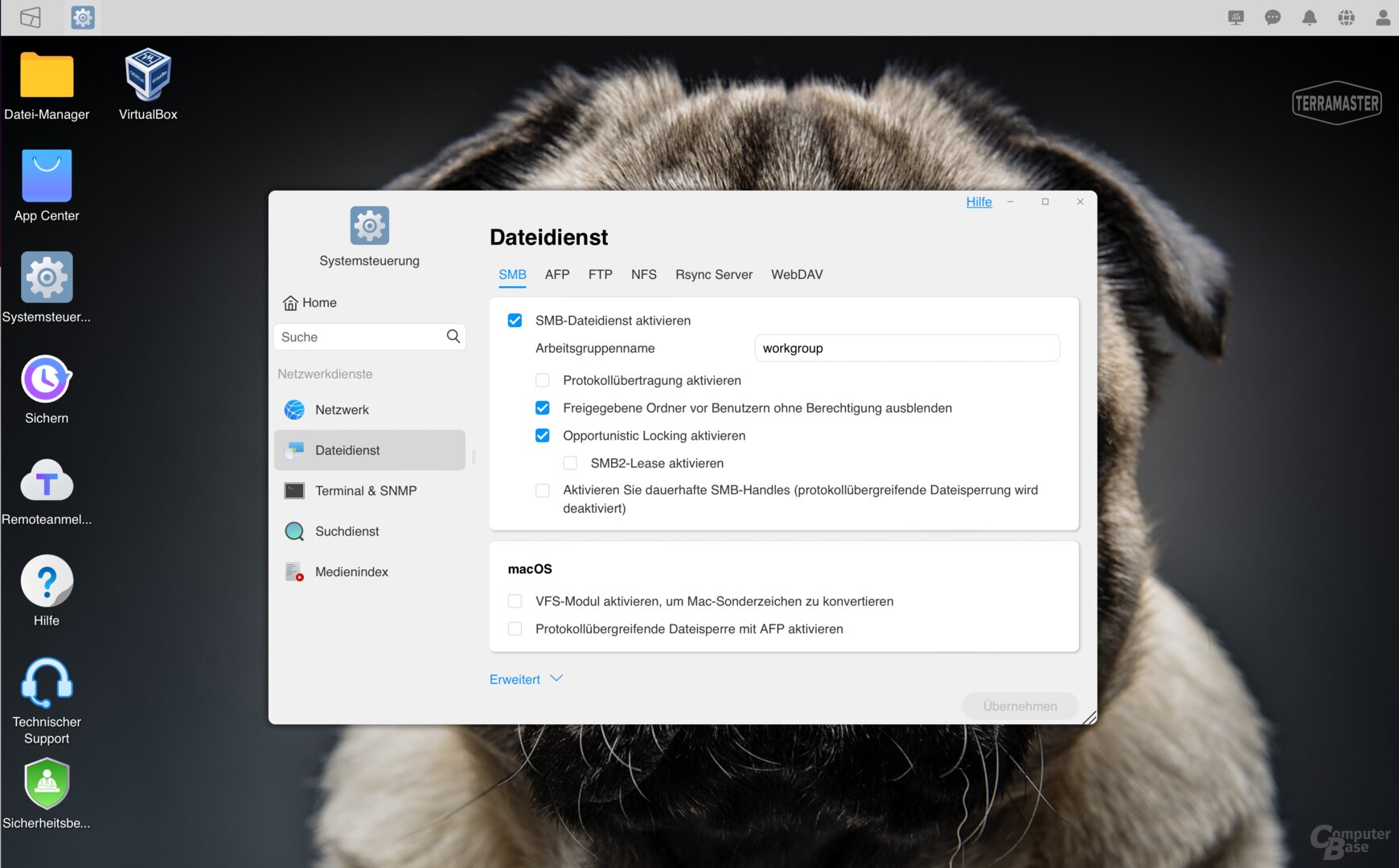
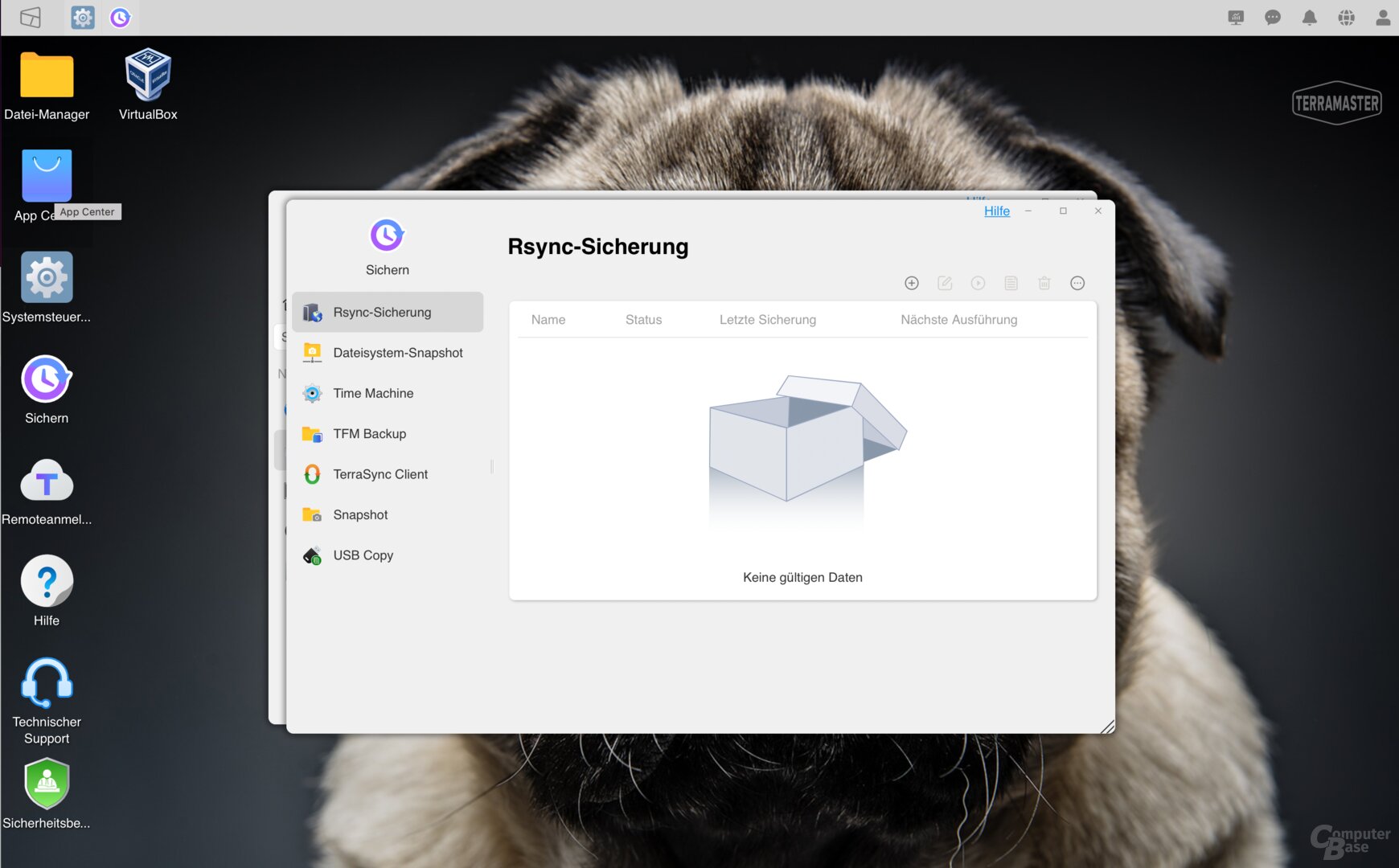
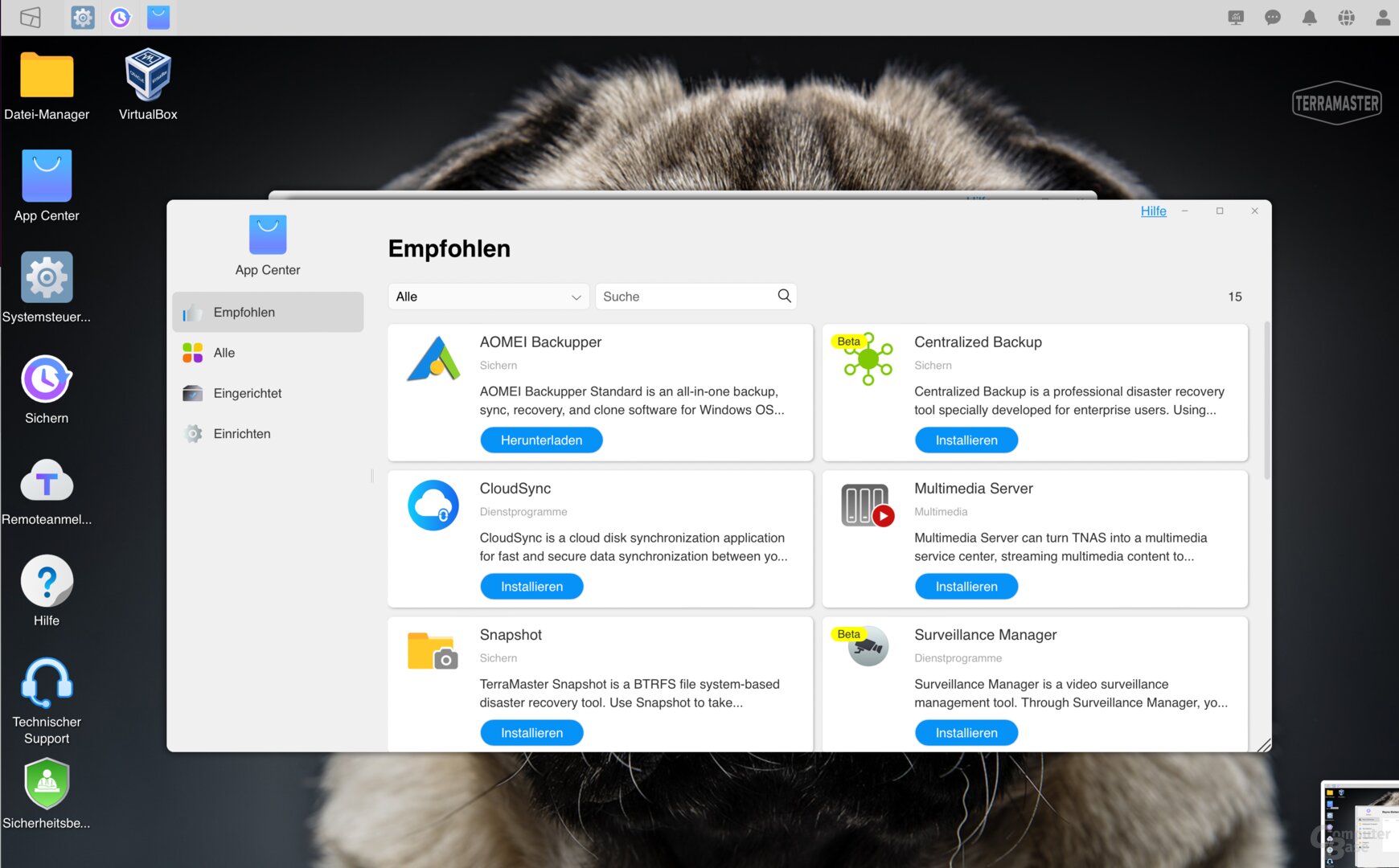

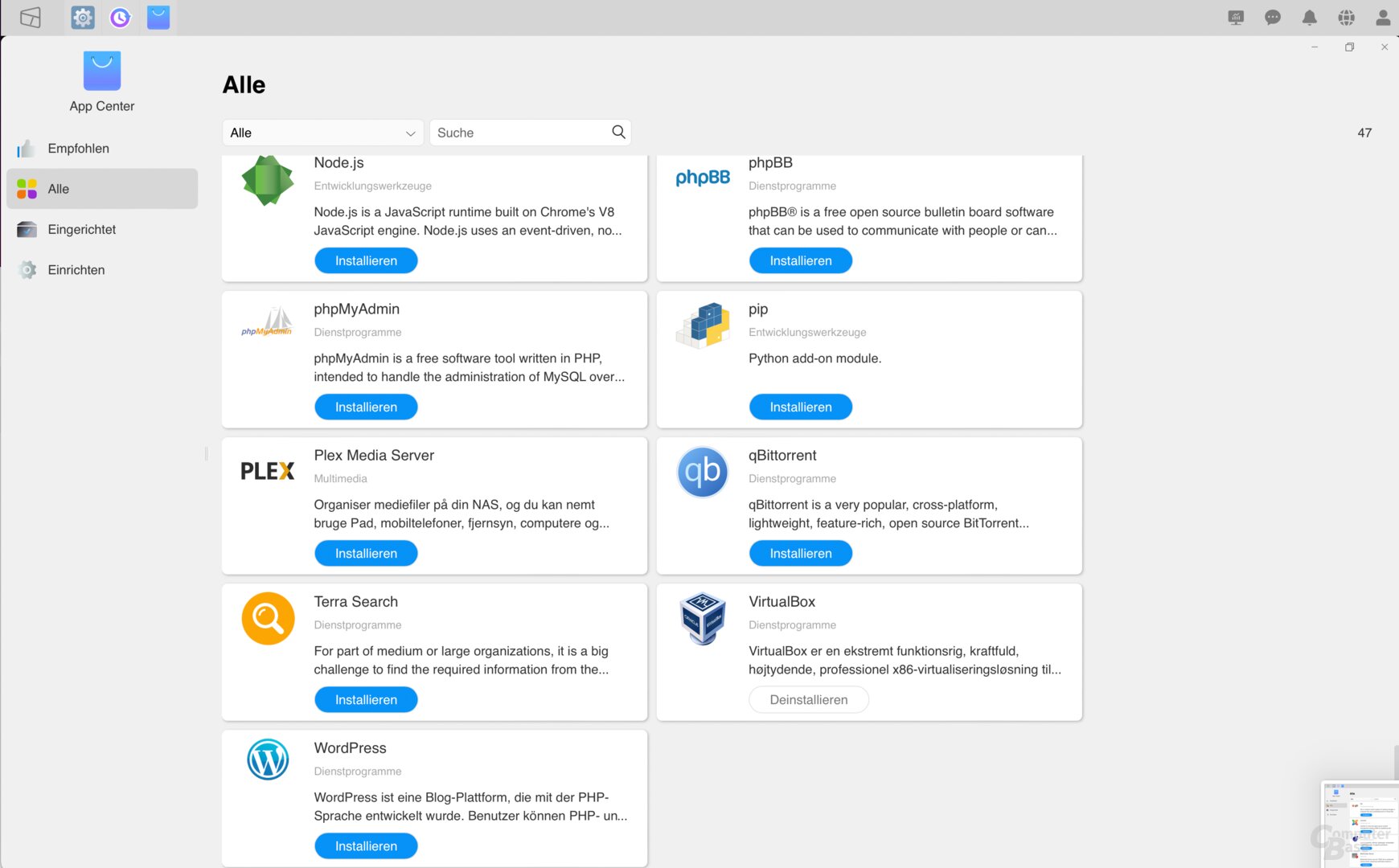
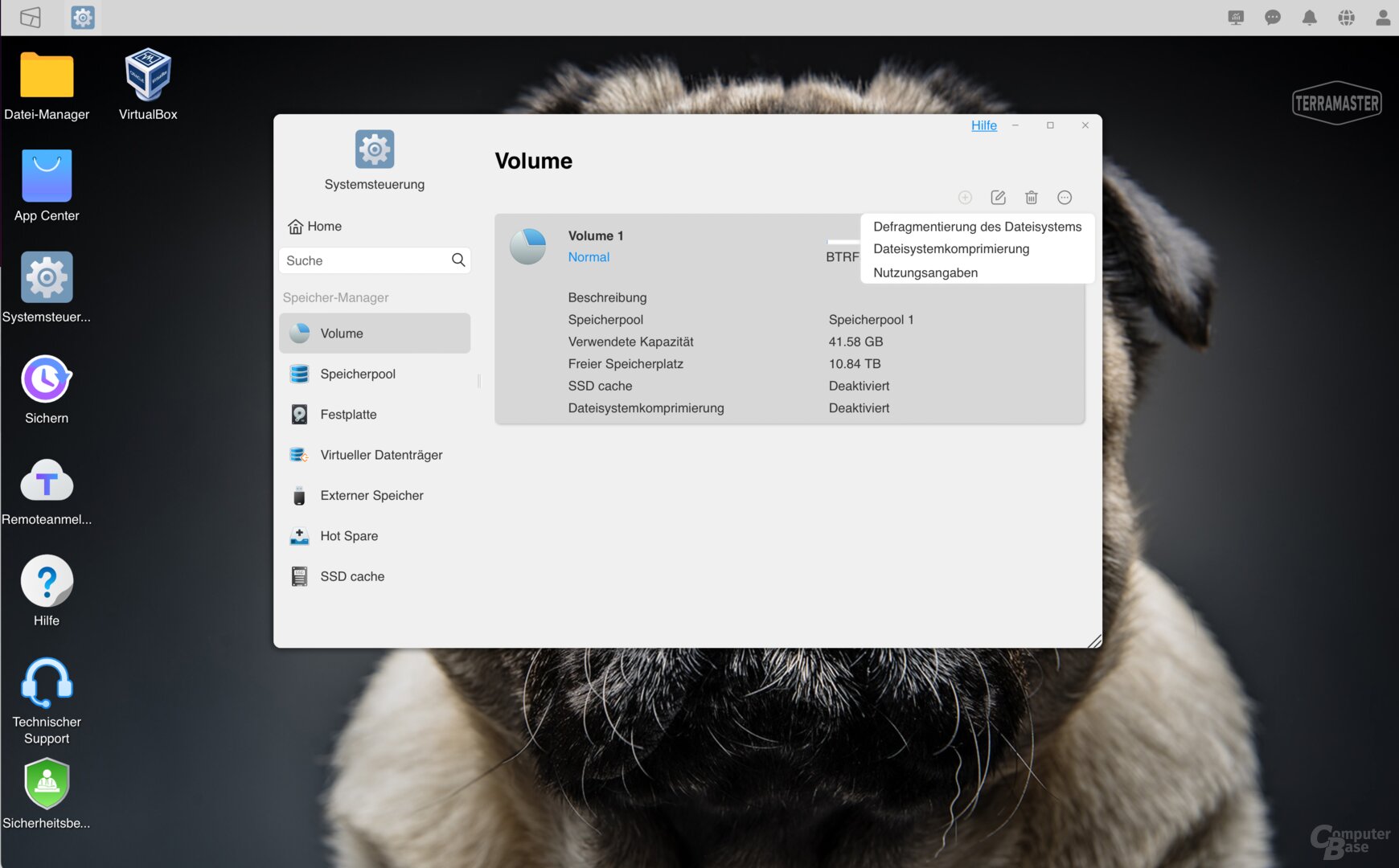
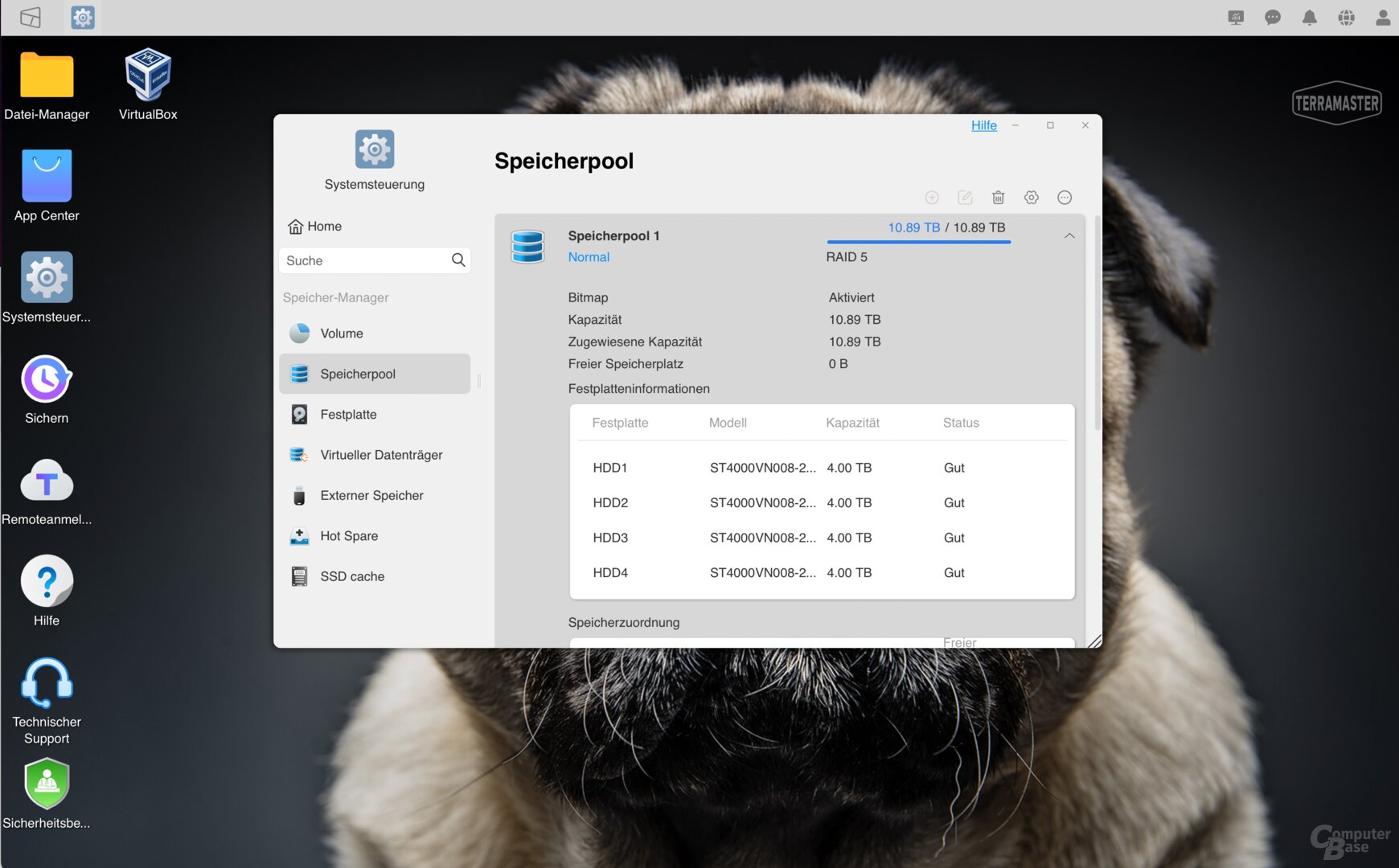
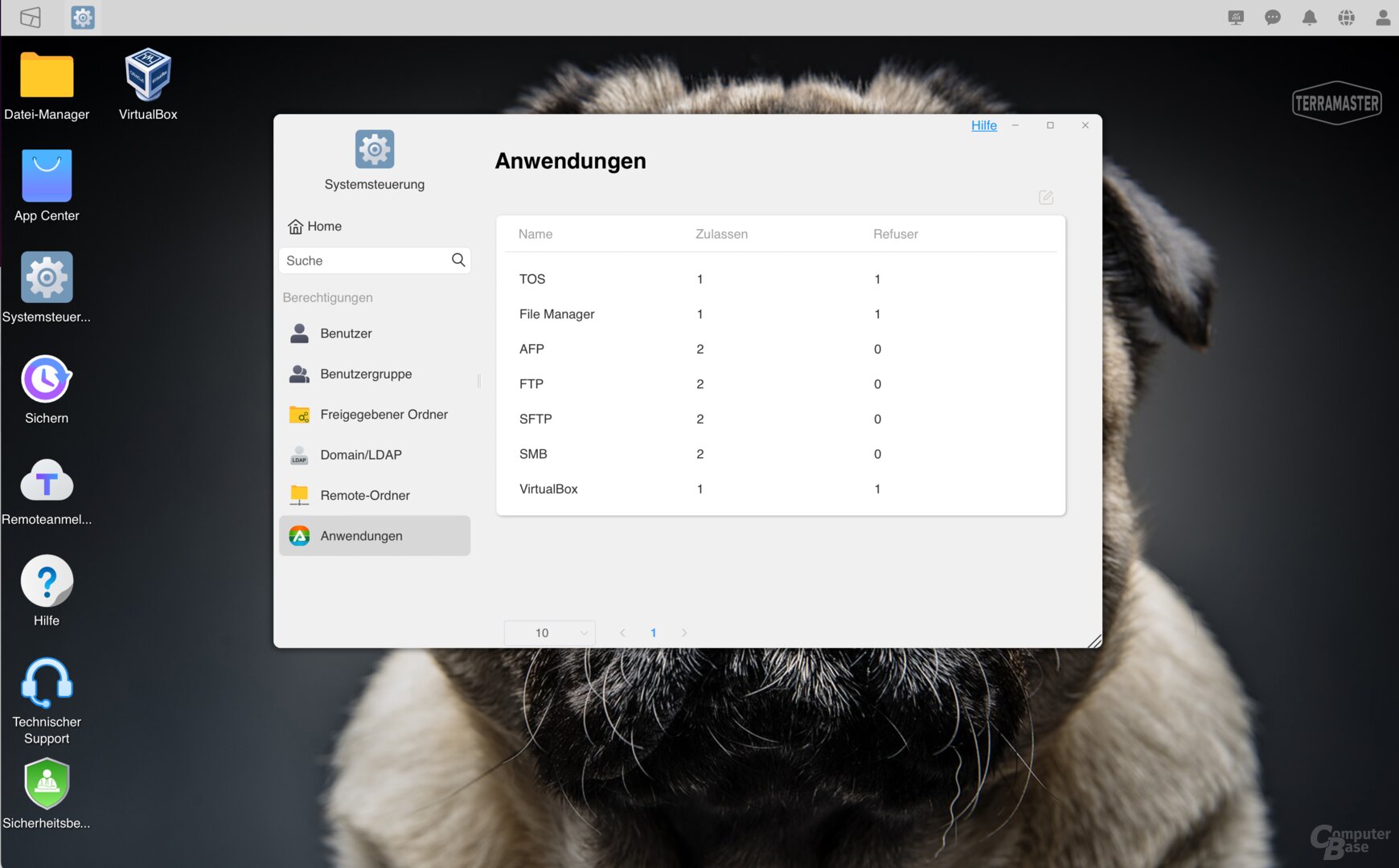
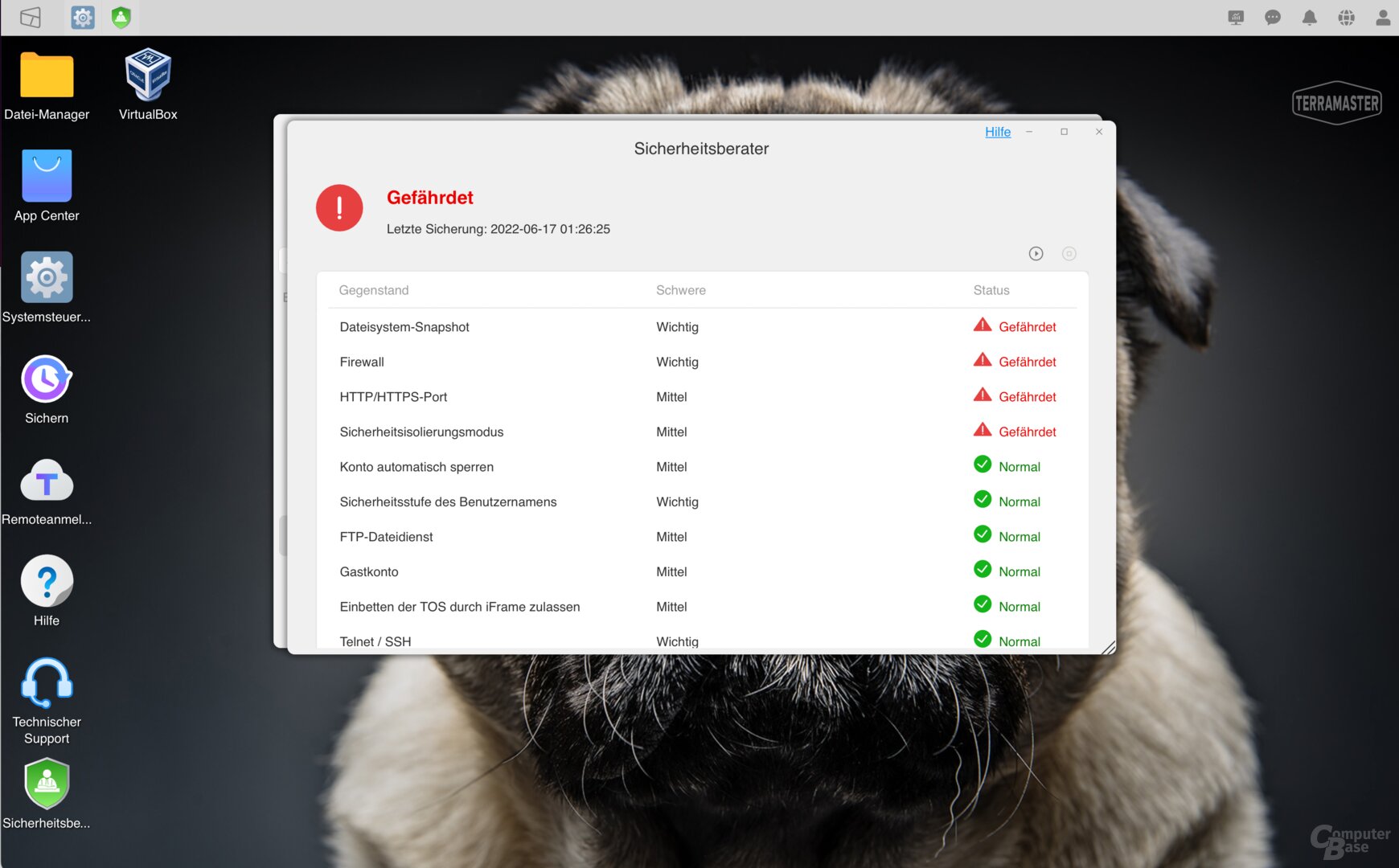
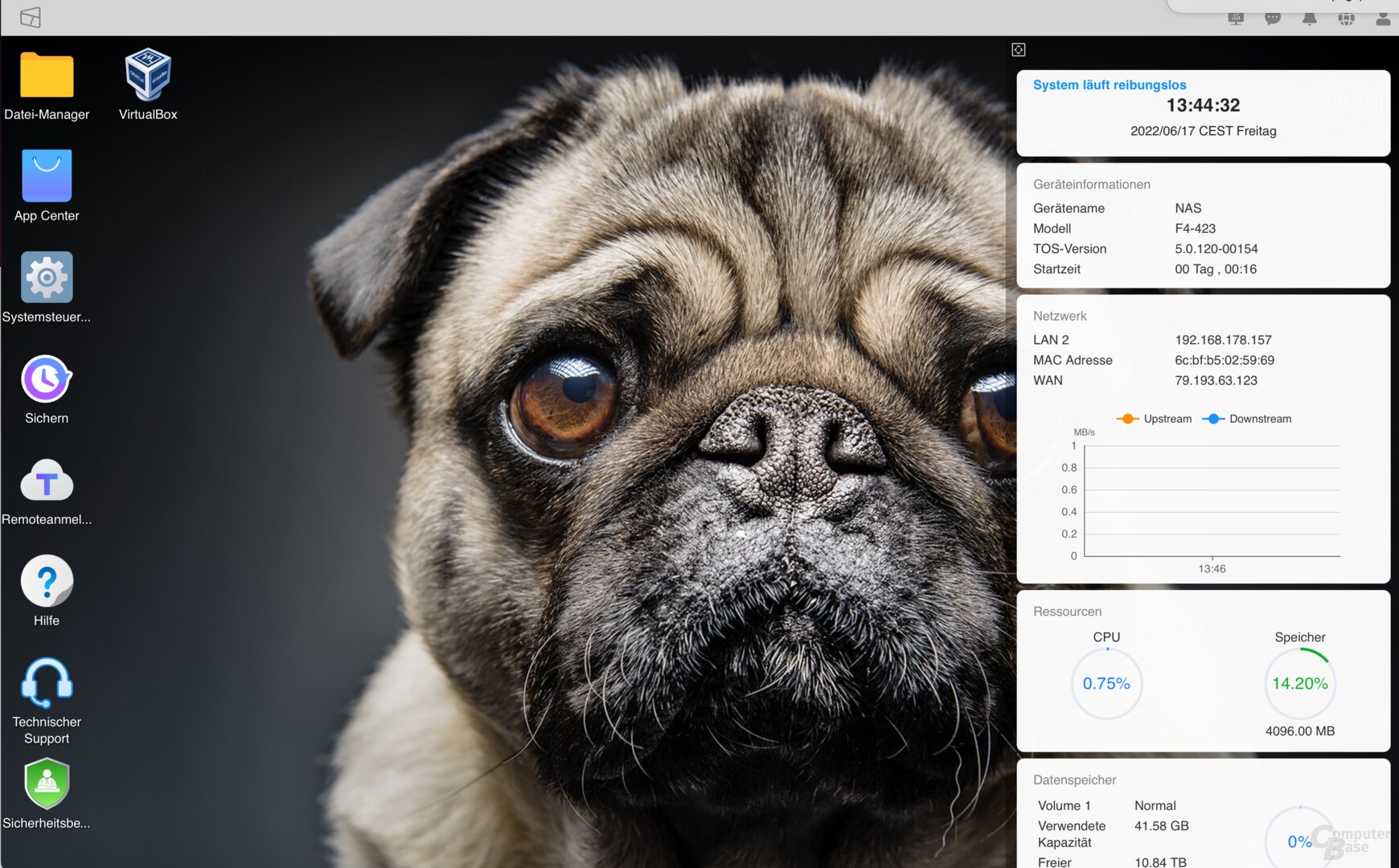
TerraMaster TOS 5 on the F4-423
TerraMaster estimates the changes in TOS 5.0 to be over 50 new functions and more than 600 improvements that have been incorporated over the course of development. More than 300,000 lines of code came together for TOS 5. For example, the storage structure and the data interaction mode have been changed, defective RAID arrays should be able to be repaired more quickly, and connected USB drives can be encrypted via the system. In addition, TerraMaster has expanded the backup options and with RAID the manufacturer brings flexible array configurations, online migration and expansion as well as redundancy strategies with increased storage space. File deduplication to reduce storage space is also supported with TOS 5. Also new is the log center, which collects system and service logs for system administrators so that they can more easily see the status of the system and services and diagnose and fix anomalies more quickly.
Update to TOS 5 requires reset
What is less user-friendly, however, is that the switch from TOS 4 to TOS 5 is not possible as a simple update via the web interface. Instead, you first have to reset the TerraMaster NAS to factory settings in order to then reconfigure it and select the update file provided by TerraMaster on TOS 5 during setup. If the file is not selected manually, TOS 4 will be installed again during the reset.
The data on the drives will not necessarily be lost during a reset. However, it is strongly recommended to back up all data externally beforehand so that you can restore it after the update if you accidentally delete it due to the settings you have made.
TOS 5.0 is only available for NAS systems with x86 architecture from the model series 220, 221, 420, 421, 422 and 423. To enable an update without data loss, at least TOS 4.2.32 must also be installed.
(*) The links marked with an asterisk are Affiliate Links. In the case of an order via such a link, ComputerBase participates in the sales revenue without the price increasing for the customer.
Page 1/3 Next page
Transfer rates, TOS 4 vs. TOS 5 and USB backup